
A Guide to Identification and Management
Insects and other arthropods are found in nearly every terrestrial and freshwater habitat on the plant. Insect abundance dwarfs all forms of visible life, and makes up more than 75 percent of all known and named animal species. Worldwide, nearly one million insect species have been named, yet entomologists estimate the total number at 2.5–5 million. That means as many as 80 percent of the world's insect species are undiscovered and yet to be named!
Insects, because of their diversity, display many different lifestyles. Certain insects spend their early life inside the body of another insect, some grow up attached to a river rock, while others spend their entire life in the grass of a front yard. This diversity also means that some insects are know to consumer or damage a wide variety of items important to people. It is not surprising that a few of those one million species can—and will—eat our food, clothing or the wood in our homes. Other insect species may be dangerous, especially those that bite, sting, transmit disease or cause allergies. Many more insects are a nuisance simply because they appear in our living space. Insects then are considered pests for a variety of reasons, and placing them into that subjective category also may justify our attempts at their elimination.
Proactive Pest Management
The origin and extent of a pest infestation is often associated with one or more conditions that promote the survival and reproduction of that particular pest. Those conditions are often referred to as life support requirements, and include:
Favorable temperatures, Abundant food and water, and Available shelter/harborage
When pest problems occur there is usually one or more of these requirements readily accessible to the pest population. Often the presence of one life support requirement will lead to an abundance of one or more of the other requirements.
The preferred living environment for most humans also provides the necessities many pests need to satisfy their life support requirements. Therefore, it is important that homeowners limit pest access to potential sources of food, water, and shelter in and around the home in an effort to keep our personal living space inhospitable to unwanted house pests. Proactive pest management is a process that begins with identifying the pest and using information on the biology of the offending creature to decide upon a plan of action. The action plan should involve interventions aimed at reducing pest population numbers or the chance for future encounters with that pest. Proactive pest management interventions will vary from one household or business to the next but there are a few overarching themes worthy of comment.

Figure 1. Spilled birdseed outdoors can be used by numerous pests, including rodents, as a food source.

Figure 2. Vegetative matter, if not disposed of or composted regularly, can be a source of pests, especially flies.
Food. General rules of cleanliness during food preparation, storage and disposal is the logical starting point for helping to resolve and prevent certain pest problems. Denying pests access to food is an important component of making our living environment less hospitable to pests. Important practices (habits to establish) that may limit insect access to food include, but are not limited to:
- Keep food in tightly sealed containers;
- Keep bird food in feeders, as rodents may use spilled food as a food source (Figure 1);
- Rotate (use) boxed or packaged foods every 1–2 months;
- Clean up spills that occur during food preparation or handling;
- Do not keep soiled dishes in the sink or dishwasher overnight;
- Empty indoor garbage receptacles twice per week, at a minimum;
- Clean garbage disposals at least once a week;
- Keep outdoor garbage in a tightly sealed container and away from any dwelling entrance;
- Rinse recyclable containers prior to recycling;? Store birdseed in a tightly sealed container, preferably outside and away from doors;
- Ensure that discarded plant waste is removed twice per week, at a minimum, especially during the summer (Figure 2).
 A
A  B
B
Figure 3. Natural harborage sites where pests can be found outdoors include (A) treeholes and (B) leaf litter.
Shelter. Shelter, also referred to as harborage, is simply a place where insects reside, rest, or hide. Specific locations become harborage because that site provides features that promote pest survival. Preferred pest harborage sites are usually protected from air movement (and its desiccating effects) and predators. They also include areas where food and water is abundant or easily accessible, and where temperatures are stable (no wide fluctuations) and optimum. When possible, pest-friendly harborages should be eliminated or pest access denied. It is unfortunate that our homes and landscaped yards provide many cracks and crevices that can be used by insect pests as harborage.
Outdoor harborages include treeholes, areas in and under fallen trees and limbs, leaf litter accumulations, and mulch and associated yard debris (Figure 3). In treeholes, cockroaches, ants, mosquitoes, and a number of other pests find a harborage characterized by moist air, darkness, and protection from the desiccating effects of wind and extreme fluctuations in temperature.
Manmade harborages include, for example, the areas underneath boards, patio stones, potted plants, garden statues, decorative rock piles, garden barriers, and other flat items lying on the ground. Keeping such garden decorations away from the foundation and exterior doors will reduce the potential for pests to harbor near the home and thus their chance of entering. Manmade harborages also include trash and garbage piles, firewood, the interior of hollow retaining walls, and the areas in and between crosstie or landscape timbers used around flower beds (Figure 4).
Figure 4. Manmade harborage sites where pests can be found outdoors include (A) the area under patio stones, (B) decorative rock piles and stones in gardens, (C) trash piles, and (D) in walls containing various voids (smoky brown cockroaches).
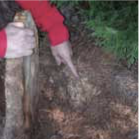 A
A  B
B 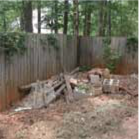 C
C  D
D
The structure itself can be viewed as a nearly endless series of manmade voids, behind cracks and crevices, that can serve as harborage for pests. Any crack or crevice in a structure that leads to a void will invite certain insect pests to harbor in that space, especially if food and water are available or the space enhances survival and growth. Common harborage sites within a structure include large areas such as crawlspaces (especially those without a vapor barrier and/or proper ventilation), attics (especially those with leaky roofs), and a wide variety of wall voids (the space defined by the interior and exterior siding on wall studs) (Figure 5). There also are numerous small voids, such as the space between the dishwasher and kitchen cabinets, the space behind baseboards, the area between built-in cabinets and the wall, inside appliances and furniture, or gaps on the exterior cladding (boards, siding, brick veneer weep holes). Structural harborages can be made unusable by sealing cracks, crevices and other entryways. Inside homes clutter also provides harborage, and sometimes food, for pests. Clutter can be defined as persistent piles of clothing, books, paper bags, boxes, papers and newspapers, recyclables, etc. (Figure 6).
 A
A  B
B
Figure 5. The structure itself is comprised of an almost endless series of voids and other potential harborage sites, such as (A) crawlspaces, and (B) the attic area behind fascia boards, where smoky brown cockroaches were living (the dark stippling is cockroach frass).

Figure 6. Indoors, clutter creates necessary harborage areas for pests.
Exterior vegetation, combined with elements related to their maintenance (mulch and irrigation), can provide pests with harborage and should be kept away from the foundation and exterior doors. It is important to maintain an exterior landscape that has a minimum of potential pest harborage sites, especially those close to the structure (Figure 7).
Property owners should limit the use of groundcovers, shrubs, vines, and deep mulch beds near the foundation of their home. These landscape features retain moisture in the soil, and thereby expand potential pest harborage areas. Mulch creates conditions that certain pests need to thrive by providing food, water and shelter. Excessive mulch provides decaying organic matter, fungi, and molds that are the food source for many small insects which then attract predatory pests such as ground beetles, spiders, and scorpions. Mulch near the home should be limited to a depth that maintains soil moisture required by the landscape plants. Groundcovers should be kept at least 1.5 ft from foundation walls. Abundant vegetation can also allow pests direct, protected access to a home, making it more likely for them to enter (because there will be more insects compared to homes without excessive vegetation, thereby increasing the chance for invasion).

Figure 7. The area next to foundation walls should be kept free of vegetation.
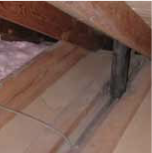 A
A  B
B 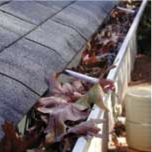 C
C 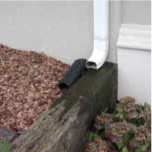 D
DFigure 8. Sources of moisture around and in structures include, but are not limited to, (A) collection of water in attics from leaky pipe penetrations on the roof, (B) collection of water behind improperly installed siding around windows (note growth of lichens, indicating excessive moisture accumulation), (C) leaf-clogged gutters, and (D) downspout exhaust too close to the structure.
Water. Excessive, persistent moisture is the most important condition allowing many types of pest infestations to establish and persist. Not only is water criticalto the health and normal metabolism of all forms of life, its abundance leads to the growth of various molds, fungi, and other microorganisms which are the primary food source for numerous insect species.
Homeowners should limit the occurrence of persistent moisture in and around their home. Moisture problems can only be remedied by correcting the underlying cause(s). Some common sources of excessive, or persistent, moisture that may lead to a pest problem include but are not limited to:
- Leaking faucets or water lines;
Condensation, for example on pipes, in walls and under insulation; Improper ventilation of walls, attics, crawlspaces, or basements; - Roof leaks, especially those that are the result of improperly installed flashing around pipe penetrations, sky lights, and chimneys (Figure 8A);
- Improper landscape grade resulting in poor surface water drainage patterns;
- Misdirected sprinkler heads;
- Gaps around windows (especially bay windows) and doors that allow water behind the structure’s exterior sheathing (Figure 8B);
- Clogged gutters and downspouts (Figure 8C);
- Downspout and air conditioner drain lines that deposit water within 5 ft of the structure (Figure 8D).
Property owners should ensure that rainwater flows away from their home by examining the grade or slope of the landscape to make certain it is appropriate; that gutters, downspouts, roof, and air conditioner condensate drainage patterns are operating properly and depositing water away from the foundation; that attics, crawlspaces, and basements are properly ventilated; that a vapor barrier is in place in the crawlspace; that sprinklers are positioned properly, and there is no standing water or persistent wet spots next to the foundation or in the crawlspace.
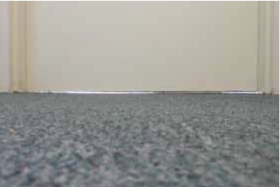
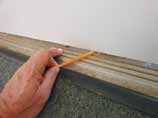
Figure 9. Crawling pests often enter structures by crawling under doors where gaps are present. The installation of a doorsweep can keep crawling invertebrates from inadvertently entering structures.
Other Practices. Homeowners can do other things to keep pests from entering the home, such as installing doorsweeps on all exterior doors, screens on all windows, ensuring that doors and windows are well-sealed when closed, and that all foundation and attic vents are adequately screened, sealed and operating properly (Figure 9). The type, position and timing of lights on the outside of buildings can make a structure less attractive to insects. Altering exterior lighting patterns has the side benefit of reducing predatory invertebrates, such as spiders and ground beetles, that feed on light-attracted insects. Yellow, red, or sodium vapor lights are less attractive to insects but can provide sufficient illumination for people. Simply changing the light bulbs used for nighttime exterior illumination or reducing the time that lights remain on can be an effective alternative in managing certain insect pests. Positioning lights away from the structure but pointing towards it results in bathing the structure in light. This lighting arrangement serves to keep insects away from the immediate perimeter of the structure, including doors and windows, yet provides sufficient illumination.
Reactive Pest Management
Pest management action plans may involve an intervention calling for the judicious use of a pesticide. The use of pesticides requires the reading and following of label directions not only to ensure the safe and effective use of the product, but also the proper storage and disposal of such products. The pesticide label is a legally binding document that describes how to handle all aspects of product usage. For example, proper personal protective measures and appropriate equipment must be used during any application of a pesticide.
Application of pesticides should be customized to the target pest. Customized applications include selecting the most appropriate formulation and applying it to areas where the target pest is most likely to encounter it. The following sections are provided for those persons interested in understanding more about the selection and use of pesticide products to manage pests in and around the home.
Product Formulations
When pesticide use is included as part of a pest management action plan it is important
to select the most appropriate formulation for the desired outcome. When considering chemical options for managing pests, selection of the appropriate formulation is as important as selection of the proper active ingredient. The following formulation types are commonly used by and accessible to homeowners in the over-the-counter market.
Baits are pesticide products that are effective only after being eaten by the pest (Figure 10). They are formulated with the active ingredient incorporated into a food source that is palatable and preferred by the target pest species. Baits are generally designed to be specific to only one or a few types of pests, are often sold in ready-to-use containers, and are to be placed, according to the label, in specific areas. Bait formulations are therefore considered more environmentally sensitive than other pesticide formulations. Over-the-counter bait products are generally limited to ant, cockroach, rat, and mouse control, and can typically be used both inside and outside the home. In the over-the-counter market baits may be available in the form of gels, pastes, liquids, pellets, granules, or blocks and are ready-to-use, according to label instructions, when purchased.

Figure 10. Baits kill pests only after being consumed by the pest, such as this smokybrown cockroach consuming a gel bait.
Granular formulations are comprised of small granules (irregular sized and up to 1/8 in. diameter) of inert material impregnated or coated with an active ingredient. Granular products are labeled only for application outdoors, and are used to control a wide variety of crawling pests by application to places where the pests live or travel—i.e., mulch, leaf litter, lawns, etc.
Granular products are most often packaged in large bags or small jugs with shaker-type tops. They are ready-to-use when purchased. It is important to note that pests do not eat products formulated as granulars. Granular formulations must be ‘activated’ (i.e., the active ingredient released from the granule) before this type of contact insecticide can be effective. The active ingredient is typically activated by a follow-up application of water in the form of irrigation or rain. Because of this, granular formulations may be less effective when applied during periods of drought. Granular products exhibit one distinct advantage over other formulation types—their weight. The weight of the granule allows the chemical to reach deep into the substrate being treated. Granular insecticide formulations are usually applied to areas like turf, mulch, ground covers, high grass, thatch, etc. (Figure 11).

Figure 11. The advantage of granular formulations is that they penetrate thick vegetation, mulch, and grass (such as this ivy) to reach harborage sites where pests live.
Aerosols, commonly known as bug spray, are a ready-to-use formulation packaged in a pressurized metal can. Aerosol formulations are comprised of an active ingredient(s) in a liquid solvent combined with a compressed gas propellant. The contents of aerosol cans are held under pressure. Some aerosol cans shoot their contents in a directed stream and are a good choice when there is a need to treat pests from a distance (e.g., paper wasps). Total-release aerosols, or bug bombs, involve an insecticide-solvent mixture that, under pressure, passes through a valve and is broken into very small droplets. The solvent evaporates quickly, leaving the lightweight droplets suspended and floating in the air. Caution should be observed when using aerosols to avoid breathing the insecticide. Although aerosols may be effective for short-term relief from pests by killing a few exposed insects, they should not be relied upon as the sole means of pest management in and around the home. Under field conditions total release aerosols have been shown to be ineffective at controlling both bed bugs and German cockroaches while leaving substantial pesticide residue on exposed surfaces.
Liquid sprays are available as both concentrates (products which must be mixed with water before use) and as ready-to-use products (products which are usable without further dilution and are often sold in 1 gallon jugs). Liquid formulations are comprised of an active ingredient that is suspended in water, and therefore applied using a hand-held pump sprayer. Liquid formulations of insecticides are intended to act as contact insecticides so they should be applied directly to the pest or to areas where pests might congregate (harborage sites) or travel. Unfortunately, research has shown that liquid formulations applied outdoors provide, under most circumstances, only temporary relief (<30 days) from invading pests.
The main human safety hazard with liquid spray insecticides is that they may be absorbed into the body through accidental contact with the eyes or skin. The personal protection equipment section of the pesticide label on any liquid formulation should be read and followed to reduce the risk of unnecessary exposure during mixing and/or application.
Liquid spray applications are rarely needed indoors, and are therefore discouraged, because a majority of the insect pests in the urban habitat live and breed outdoors. Liquid insecticide sprays perform best when applied to the exterior landscape and exterior of homes by application of spot treatments. Spot treatments are chemical interventions using a liquid formulation applied, according to label instructions, to small areas (spots) where pests are found or suspected to be harboring, breeding or entering a building. When conducting a spot treatment, it is important to apply the liquid around and to those areas where pests might enter the structure. Examples would include areas around doors (especially the threshold) and windows, inside weep holes, around crawlspace vents, and around wall penetrations where gas, plumbing, and any wire or pipe enters the building.
More on Insecticides. Additional information about insecticides, including definitions, formulations, information about how to interpret product labels and material safety data sheets (including principles of toxicity), safety, and insecticide mode of action (i.e., how insecticides work) can be found in University of Georgia Extension Bulletin 1352, Insecticide Basics for the Pest Management Professional, and Circular 998, Pesticide Safety for the Homeowner, at caes.uga.edu/publications.

Information on insecticide mode of action can be found in University of Georgia Extension Bulletin 1352, available at caes.uga.edu/publications.
Homeowner Responsibilities When Applying Pesticides. Insecticides purchased by homeowners in the over-the-counter market can be harmful to the environment and non-target organisms if overused or used in a manner not dictated by the product’s label. For instance, some insecticides are extremely toxic to fish and other aquatic life. It is therefore imperative that homeowners be familiar with a product’s label—not only to assure that the product is being used in the most efficacious manner possible, but to assure that its use is safe, legal, and environmentally responsible. Most pesticide products used by homeowners must be registered with and granted a label by the U.S. Environmental Protection Agency. A product label is a legally binding document, as described by Federal Law (the Federal Insecticide, Fungicide, and Rodenticide Act - FIFRA), on how to safely use (or not use) that pesticide product.
Any person using a pesticide must comply with the directions for use on the product’s label. Never apply more product than allowed by the label instructions. Over-application or application in a manner not consistent with the manufacturer’s directions for use on the label can harm non- target organisms, the environment, or the person applying the product. Misuse, including overuse, is a violation of the product’s label, and thus the law.
When conducting pesticide interventions outdoors, never apply a product, especially liquid spray and granular formulations, where water runoff might carry the pesticide into a body of water—creeks, streams, lakes, ponds, and rivers (Figure 12). Moreover, never apply a pesticide during rain or when rain is imminent. When applying granular formulations, always sweep granules from hard surfaces (e.g., patios, walkways, and driveways) onto grassy areas so they cannot be washed into waterways. Likewise, liquid spray formulations should not be applied to surfaces or areas where rain might wash the pesticide into storm drains.
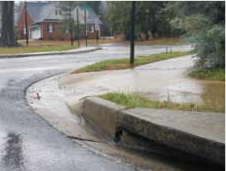

Figure 12. Homeowners must be responsible about the use of pesticides on their property. The irresponsible use of pesticides on private property can result in (A) runoff into storm drains (yellow arrow) that eventually end up in (B) environmentally sensitive creeks, streams, lakes, ponds, and rivers. Always read and follow label instructions when applying any pesticide product.
Ultrasonic Pest Management Devices (UPMD). All studies of UPMDs published in peer- reviewed scientific journals have demonstrated that these devices do not kill or repel insect pests. Studies with cockroaches, fleas, ticks, ants, and mosquitoes conducted by independent laboratories at major research universities have never provided evidence that product claims are accurate. No UPMD has ever worked when tested by rigorous, scientific evaluation.
Services for Termites & Bed Bugs. Homeowners should not attempt to treat their home or premises for an existing termite or bed bug infestation. The tools and training needed to conduct a proper inspection, as well as access to the products and equipment required to rid a home of termites or bed bugs, are uniquely available to certified, registered pest management professionals. The most important challenge when attempting to rid a premise of termites or bed bugs is locating and properly intervening, with pesticidal and non-pesticidal interventions as appropriate, the area(s) where these insects are found and in following up after the intervention(s). These goals can best be accomplished by a professional. To learn more about subterranean termites see University of Georgia Extension Bulletin 1241, Termite Control Services: Information for the Georgia Property Owner and Bulletin 1209, Biology of Subterranean Termites in the Eastern United States, at caes.uga.edu/publications. For additional information on bed bugs, visit epa.gov/bedbugs.
Hiring a Professional Pest Management Company
Although some pest problems can be remedied by the homeowner, the advice to hire a pest management professional is recommended when structural pests or other persistent pest problems arise. Homeowners can be assured that pest management professionals are skilled in the art of solving pest problems, and that they are certified by their state regulatory agency for the safe use, storage, and disposal of pesticides.
When a professional is needed, it is important to select a company committed to customer service, especially if the homeowner is considering entering a long-term service agreement. Some tips on hiring a pest management company may include:
-
Ask friends, neighbors, and co-workers about their experiences and interactions with pest management professionals. Selecting a professional pest management company is not unlike selecting other service providers, such as electricians and plumbers. Consistently good recommendations are still one of the most reliable means of selecting a quality service provider.
-
Avoid going to the yellow pages and selecting a company based solely on an advertisement. Furthermore, do not hire a company based on treatment price alone. A variety of factors should be considered when making a decision on which company to hire.
-
Contact the appropriate regulatory agency to ensure that prospective companies are licensed. In Georgia, the Department of Agriculture (agr.state.ga.us) is the agency that regulates the pest control industry.
-
Ask prospective companies to describe their commitment to the continuing education of their employees. Although all technicians in Georgia are required to attend state-approved continuing education seminars, some companies provide in-house training or send their employees to university- or state-sponsored training programs and workshops that are above and beyond that required by the state.
-
Ask prospective companies whether they are a member of their state and/or national pest control organization(s). Membership in these organizations suggests that the firm is well-established and that the owners are active in their profession. Membership also suggests that owners and managers attend national and state conferences where insight into key issues facing the pest control industry are highlighted and discussed, and the most recent findings on pest control research and application technology are presented.
- Ask prospective companies whether they have on-staff technical personnel, such as an entomologist, who can assist with pest identification, pest control recommendations, client education, and evaluation of the quality and effectiveness of delivered services.
Identification, Habits, and Recommendations for Interventions for Specific Pests in the Urban
& Suburban Environment
The following section includes images and notes pertaining to the identification and management of many of the most common insect pests likely to be encountered by homeowners in the urban and suburban residential environment. This section is intended to be used in conjunction with University of Georgia Extension Special Bulletin 48, Georgia Pest Management Handbook: Homeowner Edition, Household Pests Chapter, which can be found at caes.uga.edu/publications. In combination with the Proactive Pest Management strategies discussed previously, the Handbookis a list of specific, over-the-counter products recommended for control of the various pests found in the following pages.
For additional help, contact a local county Cooperative Extension agent by calling 1-800-ASK-UGA1 or visit the University of Georgia’s Cooperative Extension website at ugaextension.com.
The pests treated below are found in the urban and suburban residential environment and are arranged according to the type of insect they represent; as an example, all beetles, or the order Coleoptera, are treated together; all ants, bees, and wasps, or the order Hymenoptera, are treated together, etc. Ordinal, family, and species-level names are provided for the majority of these common home pests. All family-level names end with -idae. Scientific names (genus and species) of individual pests are italicized.
Crickets (Order Orthoptera)
Field crickets (Gryllidae: Gryllus spp.): Body dark brown with enlarged hind legs for jumping; about 3/4 in. Habits: Found outdoors in wood piles and under flat items, such as boards, lying on the ground. Adult populations peak in late summer. Interventions: Follow suggestions under section titled Proactive Pest Management. It is especially important to eliminate harborage and install doorsweeps. Spread granular bait in areas where crickets are found. If desired, apply an appropriately labeled residual spray directly to crickets (spray only outdoors). Might Be Confused With: various cockroach species, camel crickets.
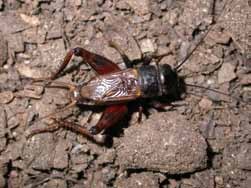
Field cricket
Camel crickets (Rhaphidophoridae):Up to 1.5 in., mottled gray/brown, hump-backed crickets with large hind legs that enable it to jump high and far. Camel crickets have long, slender antennae. Habits: Camel crickets are common inhabitants of crawlspaces, wall voids, basements, sheds, and other areas where humidity is high. They are commonly found living in the same areas as smokybrown cockroaches and cellar spiders. Interventions: Properly ventilate, dehumidify, or otherwise dry those areas where camel crickets are found. Spread granular bait or apply gel bait in areas where camel crickets are found. If desired, apply a spot treatment with an appropriately labeled residual spray to those areas where camel crickets are found. Might Be Confused With: various cockroach species, field crickets.
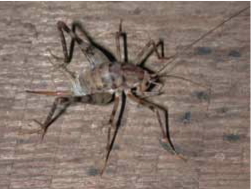
Camel cricket
Cockroaches (Order Blattaria)
Cockroaches are large, night-active, fast-moving insects with a broad, flattened body, long antennae, and a relatively small head. The front pair of wings (called tegmina) are tough, protective, and lay on top of the membranous hind wings. Most cockroaches are poor fliers. None of the cockroach species listed below is indigenous to the U.S., but all are well established.
American cockroach (Blattidae: Periplaneta americana): Adults are large (2 in.) with pale outer margins on the pronotum (upper thorax). Chestnut to light brown-colored insects that run quickly. Males and females are visually indistinguishable, although females are a little wider posteriorly than males. Habits: Mainly found in sewers and other dark, damp hideaways such as basements. Rarely, if ever, found in attics. Night active. Sometimes found cohabiting outdoor harborage sites with smokybrown and/or Oriental cockroaches. Interventions: Apply gel baits (multiple small dabs no larger than a pea) or broadcast granular baits in areas where cockroaches are found. Bait stations can be used to control small nymphs, but adults and large nymphs may be too big to fit into the small openings in most bait stations. Might Be Confused With: smokybrown cockroach, Oriental cockroach.
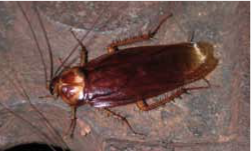
American cockroach
Smokybrown cockroach (Blattidae: Periplaneta fuliginosa): Adults are large (1.5 in.) and uniformly dark cherry to dark red colored. Males and females are visually indistinguishable, although females are a little wider posteriorly than males. First instar nymphs approximately 1/8 to 3/16 in., and identified by the white band across their back, just behind the thorax, and a white band on the tip of the antennae. Habits: Most common cockroach in suburban, Southern neighborhoods with mature hardwood trees present, where they commonly live in treeholes, attics, crawlspaces, sheds and similar harborages with high humidity and protected from the desiccating effects of wind. Not commonly found in kitchens, as is the German cockroach. Night active. Sometimes found cohabiting outdoor harborage sites with American and/or Oriental cockroaches. Rarely, if ever, found in sewers. First instars not very mobile; their presence suggests nearby egg case hatch. Interventions: Apply gel baits (multiple small dabs no larger than a pea) or broadcast granular baits in areas where cockroaches are found. Bait stations can be used to control small nymphs, but adults and large nymphs may be too big to fit into the small openings in most bait stations. Might Be Confused With: American cockroach, Oriental cockroach.

Smokybrown cockroach
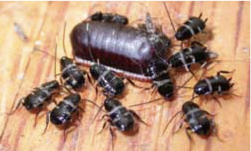
Smokybrown cockroach nymphs (first instars)
Oriental cockroach (Blattidae: Blatta orientalis): Adults are large (1 to 1.25 in.) and cherry to black colored. Males with short wings that do not completely cover the abdomen; females wingless (wingpads only). Habits: Sometimes found cohabiting outdoor harborage sites with smokybrown and/or American cockroaches. Night active. Rarely found around homes in suburban environments. Biology and habits more similar to the American cockroach than the smokybrown cockroach. Interventions: Apply gel baits (multiple small dabs no larger than a pea) or broadcast granular baits in areas where cockroaches are found. Bait stations can be used to control small nymphs, but adults and large nymphs may be too big to fit into the small openings in most bait stations. Might Be Confused With: smokybrown cockroach, American cockroach.

Oriental cockroaches
Asian cockroach (Blattellidae: Blattella asahinai): Adults of both sexes about 1/2 to 5/8 in., tan colored with dual, parallel stripes on back of pronotum (upper thorax). Males and females are visually indistinguishable. Habits: Attracted to light, readily flies (rare for a cockroach), and found in shaded areas outdoors with leaf litter, mulch and/or high grass present. Rarely found indoors, unless attracted there by light. Flies during the day in response to disturbance (walking through habitat). Interventions: Alter lighting to make structure less attractive at night (see section on Proactive Pest Management). Broadcast granular bait in areas where cockroaches are found. If desired, apply an appropriately labeled residual spray to those areas where cockroaches are found. Might Be Confused With: German cockroach.
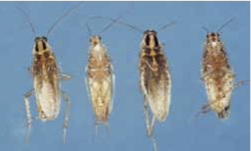
Asian cockroaches
German cockroach (Blattellidae: Blattella germanica): Adults of both sexes about 1/2 to 5/8 in., tan colored with dual, parallel stripes on back of pronotum (upper thorax). Males and females are visually indistinguishable. Habits: Obligate indoor pest, never to rarely found outdoors except in cases of extreme indoor infestations. Found mainly in kitchens near and in warm appliances and sources of water. Night active. Under extreme levels of infestation this cockroach may be responsible for allergies, especially in children. Interventions: Use pheremone-based sticky traps to highlight areas of activity. Use gel baits and bait stations in areas (mainly in kitchen under the sink, next to the garbage, under/next to the refrigerator and stove, and in infested drawers) where German cockroaches are found. In moderate to heavy infestations, as many as 12–15 bait stations may be needed in a standard-sized home. Place bait stations on flat surfaces in corners and along edges of walls. When using gel baits, the application of many small bait ‘spots’ is preferred to the application of a few large bait spots (it does not take much bait to affect a large number of German cockroaches). If desired, in cases of extreme infestation apply a spot treatment with an appropriately labeled residual spray inside cracks and crevices where cockroaches are found. Total release aerosols (bug bombs) are ineffective at controlling German cockroaches, and should not be used indoors. Might Be Confused With: Asian cockroach.
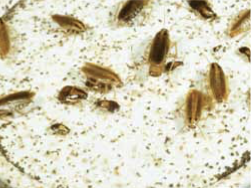
German cockroaches
Termites (Order Isoptera)
Termites are eusocial insects that live in colonies that, at maturity, number from several hundred to several million individuals. A colony contains nymphs, workers, soldiers, and reproductive individuals of both sexes. The commonly encountered species are economically significant pests that can cause serious structural damage to buildings.
Subterranean termites (Rhinotermitidae: Reticulitermes spp., Coptotermes formosanus): Winged reproductives, called swarmers, are most often seen in spring, but can be observed at any time of year. All four wings are the same size. Swarmer body color is black to caramel colored and 1/8 to 3/16 in. Habits: Subterranean termites live in the soil, and forage into structures to gain access to wood. They excavate galleries in wood as they consume it, sometimes leaving only a thin wooden exterior. Termite workers, but not swarmers, eat wood. Swarmers are the most common sign of termite infestation when they swarm from any part of a structure or home. Outdoor swarms from fence posts, stumps, etc. are signs of an active colony in the area or yard but not necessarily a sign of structural infestation. Interventions: A good preventative strategy is to have the home inspected annually for termites. If an infestation is present, seek help from a professional termite control company. Homeowners should not attempt to treat a structure for termites. The products and equipment used by professionals are not available to the novice. For more information see University of Georgia Extension Bulletins 1241, Termite Control Services: Information for the Georgia Property Owner, and 1209, Biology of Subterranean Termites in the Eastern United States, at caes.uga.edu/publications. Might Be Confused With: drywood termites, earwigs.
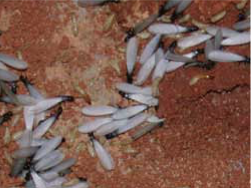
Subterranean termite swamers are often the first sign of an infestation.
Drywood termites (Kalotermitidae: Incisitermes spp., Cryptotermes brevis):Adult termites rarely seen. Other than a swarm, the most common outward sign of infestation is the continued appearance of uniform sized fecal pellets (frass) which are usually found on a flat surface directly underneath infested wood. All pellets same size (grain of sand) and color of infested wood. When cleaned up, pellets return because termites continue to discharge them from infested wood. Habits: Drywood termites do not need contact with soil, as do subterranean termites, or any form of liquid moisture as they get all their moisture from wood and metabolic water. Colonies of drywood termites are small in number. In Georgia, they are most commonly found in furniture, picture frames, etc. in the central and northern parts of the state, but native species can be structural pests in south and southeast Georgia. They can also be found in wood items that had originated in Gulf Coast states or California—all states where drywood termites are native. Interventions: Homeowners should not attempt to treat a structure for drywood termites for the same reasons mentioned under subterranean termite interventions. There are several options to discuss with a professional. For example, if the structure is infested, structural fumigation should be considered. An alternative would be spot treatment of active galleries, preferably with a dust or foam formulation. A structural infestation might also be remedied by wood removal and replacement, if possible, following thorough inspection. Infested furniture can be removed from the home, fumigated, and returned. Might Be Confused With: subterranean termites.
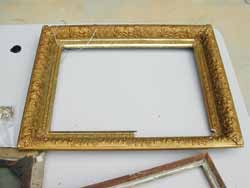
Picture frame infested by drywood termites.
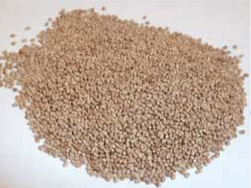

Drywood termite fecal pellets (frass) and close-up.
True Bugs (Order Hemiptera)
A group of insects known as the true bugs, the Hemiptera (suborder Heteroptera), include such common insects as bed bugs, stink bugs, and those discussed below. They all possess piercing-sucking mouthparts, and most species have forewings with both membranous and hardened portions (called hemelytra). True bugs are represented by plant feeders, predators, and blood feeders.
Wheel bugs (Reduviidae: Arilus cristatus): Large, 1 to 1.25 in. silver insect with a distinct wheel-shaped pronotum (upper thorax). Habits: Wheel bugs are predatory, and eat other insects. They have piercing-sucking mouthparts, and may bite if handled. Interventions: Usually, wheel bugs are not so plentiful to require insecticide treatment. If present, and control warranted, try crushing or directly spraying individual bugs with an aerosol insecticide labeled for general insect pests. Widespread insecticide treatments are not needed. For more information see University of Georgia Extension Circular 782, Stinging and Biting Pests, at caes.uga.edu/publications. Might Be Confused With: beetles, stink bugs.
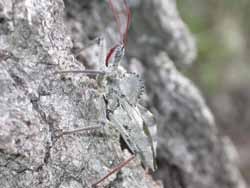
Wheel bug
Boxelder bugs (Rhopalidae: Boisea trivittata): Adults are 1/2 to 5/8 in., with red eyes, and are black with orange to red stripes. Immatures are wingless, black and orange/red. Habits: Boxelder bugs are a nuisance pest in the fall. In addition to finding individuals, in some cases bugs are found in mixed aggregations of adults and nymphs as they prepare to overwinter. Feeds on leaves and seeds of boxelder and silver maple trees. Interventions: Because boxelder bugs are harmless, follow suggestions (summer) under section titled Proactive Pest Management. Important to ensure window and door screens are intact and that doorsweeps are installed properly. If insect problems are such a nuisance that they require treatment, treat bugs directly with an appropriately labeled residual spray (spray only outdoors). If bugs get inside the best solution is to vacuum them. If bugs die inside walls or in attics their carcasses can accumulate and attract other insects that eat them, especially carpet beetles. Might Be Confused With: milkweed bugs (Lygaeidae), golden raintree bugs, stink bugs.

Boxelder bugs
Kudzu bugs (Plataspidae: Megacopta cribraria): Wider posterior than anterior, about 3/16 to 1/4 in. Red eyes, green to brown body with stipples present on wing covers. Distinct odor. Habits: Flies to light-colored surfaces (buildings and automobiles), from nearby kudzu patches, in October/November as it looks for overwintering sites. Active again in spring (February to April) as it awakes from Winter slumber. Native to Asia, was discovered in Georgia (and the Western Hemisphere) for the first time in October 2009. Feeds on kudzu as well as other legumes, including soybeans. Interventions: Before kudzu bugs begin to move (October), take action to (1) seal all cracks 1/8 wide or wider, and (2) spot spray around all potential entry points with an appropriately labeled residual spray. Reapply insecticide treatments, per label specifications, through the end of November. Interventions should be implemented early enough (mid-September) so that preventative measures are in place before the onset of kudzu bug movement. In summer, remove kudzu if possible. It is especially important to make sure all windows are screened, that doors remain closed, and doorsweeps are installed on all exterior doors. As temperatures decline into the Winter months kudzu bugs become less of a nuisance. Might Be Confused With: lady beetles, brown marmorated stink bugs.
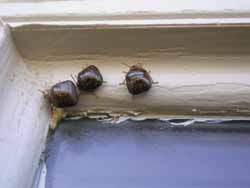
Kudzu bugs
Brown Marmorated Stink bugs (Pentatomidae: Halyomorpha halys): Brown marbled- or mottled-colored stink bug, 5/8 in., adults with distinctive white-banded antennae. Habits: First discovered in northwest Georgia in 2010, this invasive Asian species was first reported in the U.S. in Pennsylvania in 1996. An important agricultural pest of fruit crops as well as row crops and vegetables. Like the kudzu bug, boxelder bug, and multicolored Asian lady beetle, this bug is attracted to homes in the fall in search of overwintering sites, sometimes in large numbers. Interventions: Follow suggestions under section titled Proactive Pest Management, especially the installation of doorsweeps and screens. Before brown marmorated stink bugs begin to seek refuge indoors (fall), take action to (1) seal all cracks 1/8 wide or wider, and (2) spot spray around all potential entry points with an appropriately labeled residual spray. Reapply insecticide treatments, per label specifications, through the end of November. Interventions should be implemented early enough (mid-September) so that preventative measures are in place before the onset of stink bug migration indoors. It is especially important to make sure all windows are screened, that doors remain closed, and doorsweeps are installed on all exterior doors. If bugs get inside the best solution is to vacuum them. Insecticide treatments indoors are not recommended. If bugs die inside walls or in attics their carcasses can accumulate and attract other insects that eat them, especially carpet beetles. Might Be Confused With: kudzu bugs, lady beetles.
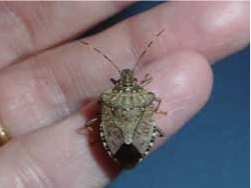
Brown Marmorated Stink bug
Bat bugs (Polyctenidae: several species): Small (1/16 to 3/16 in.), flattened, reddish brown-colored insect nearly identical in visual appearance to the common bed bug. Habits: Bat bugs are parasitic insects that prefer to feed on bats and are therefore typically found in attics. Bat bugs rarely bite people. They appear in areas where it is not logical to find bed bugs (on window sills, in the middle of a room, kitchen, etc.). Bat bugs may invade human living spaces after bat infestations are eliminated, and can continue to move from the bat infestation site (usually the attic) into living areas for months after bats are excluded. Interventions: Capture several bugs, place them in a vial or jar, and obtain positive identification from an entomologist. If positive bat bug identification is made, contact a pest management professional. Bat bug control should target (including a thorough inspection) the source of the bugs. Might Be Confused With: common bed bugs.

Bat bug
Common Bed bugs (Cimicidae: Cimex lectularius): Small (1/16 to 3/16 in.), flattened, reddish brown-colored insect nearly identical in visual appearance to the bat bug. Habits: Bed bugs are parasitic insects that prefer to feed on human blood. Found in locations where people rest, especially bedrooms, couches, etc. Found resting in cracks and crevices from which they emerge at night to feed on blood of their human hosts. Common resting sites include mattress seams, box spring screw holes, under nightstands, behind wall hangings, behind headboards, under the carpet along the baseboard (especially in corners), etc. Like other blood-feeding arthropods (ticks, fleas, and mosquitoes), bed bugs are attracted to carbon dioxide, as it is indicative of a warm-blooded host. Interventions: Capture several bugs, place them in a vial or jar, and acquire positive identification from an entomologist. If a positive identification is made, contact a pest management professional skilled and experienced in the treatment and elimination of bed bug infestations. Bed bug elimination is very difficult, and should be left to an experienced professional. Total release aerosols (bug bombs) are ineffective at controlling bed bugs, and should not be used indoors. For additional information on bed bugs, visit epa.gov/bedbugs. Might Be Confused With: bat bugs, carpet beetles.
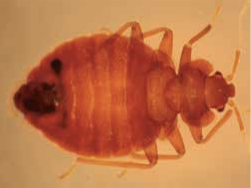
Common Bed bug
A Chinch bug (Blissidae: Ischnodemus sp.): Cigar-shaped, black insect, 3/8 to 1/2 in., with triangle-shaped head, short antennae, and silver wings. Habits: In Georgia, found most commonly on exterior walls in the fall (September–November). Adults and nymphs are leaf feeders, causing damage to leaf tissue of mostly grasses (for example, flat sedge and related sedges in Georgia) by disrupting and depressing overall plant growth. Its feeding undoubtedly influences flowering and seed production. Interventions: Chinch bug populations are likely to subside on their own as the seasons change; if given enough time the problem is likely to take care of itself. Follow suggestions under section titled Proactive Pest Management, especially the installation of doorsweeps and screens. If insect problems are such a nuisance that they require treatment, treat bugs directly with an appropriatelylabeled residual spray (spray only outdoors). Might Be Confused With: boxelder bugs.
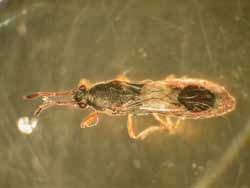
A Chinch bug
Beetles (Order Coleoptera)
All beetles can be recognized by two pairs of wings. The front pair (called elytra) are hard and thickened or shell-like; elytra cover and protect the membranous flight
wings underneath.
Ambrosia beetles (Curculionidae: Scolytinae: many species): Small (1/8 to 3/16 in.), robust beetles. Head concealed and protected by rounded pronotum (upper thorax); antennae with large, flat club. Habits: Adults burrow into wet, newly cut wood to create galleries where they deposit eggs. The adult inoculates the secluded galleries with a fungus, referred to as ambrosia, that the larvae eat. Ambrosia fungus needs wet conditions to grow (i.e., newly cut wood or recently debarked logs). The galleries are stained blue by the fungus. Ambrosia beetles do not eat wood. Interventions: Beetle problems disappear when the wood dries out. Insecticide treatments are rarely needed and not useful because these beetles (adults and larvae) do not eat the wood. Might Be Confused With: various powderpost beetles.
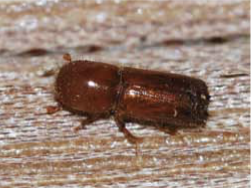
Ambrosia beetle
Powderpost beetles (Anobiidae and Bostrichidae: various species): Powderpost is a term used to describe several species of wood-eating beetles that feed (as larvae) on lumber (e.g., crawlspaces) and furniture grade (e.g., flooring) wood and that reduce the wood to a fine, flour-like powder (called frass). Frass is insect excrement. The most common families of powderpost beetles are the Anobiidae and Bostrichidae (including Lyctinae). Anobiid and non-lyctine bostrichid powderpost beetles attack both hardwoods and softwoods, whereas lyctines attack only hardwoods. All three can re-infest the wood from which they have just emerged, but lyctines and anobiids more so than bostrichids. Wood attacked
by lyctine and anobiid powderpost beetles can be greatly damaged. Characteristic signs of powderpost beetle activity is the presence of small, round holes (1/16 to 5/16 in. diameter) in the wood. The holes are the result of the adult beetle, having just emerged from its pupal case, chewing its way out of the wood to free itself to the outside. When adult powderpost beetles emerge from the wood, they emerge perpendicular to the wood’s surface, creating an almost perfectly round exit hole. Active infestations are characterized by frass streaming from or accumulating around the exit hole on the wood’s surface. Adult powderpost beetles are rarely seen. Exit holes with no frass present is evidence of a prior infestation, but not necessarily one that is still active.
Anobiid powderpost beetles (Anobiidae: Euvrilletta peltata): The broad-diet anobiid powderpost beetle, E. peltata, is about 1/4 in., and reddish brown to dark brown. Body cylindrical, elongated, covered by fine, gold-colored hair and with long, serrated antennae. Elytra lined with rows of tiny pits. Head covered by the hood-like pronotum (upper thorax) when viewed from above. Adults, however, are rarely seen. Active infestations in crawslpaces usually diagnosed by the presence of joists with frass streaming from beetle exit holes. Live adults most commonly found on crawlspace joists in June in Georgia during their annual three to six week period of emergence. Other representatives of this group include the furniture beetle (Anobium punctatum), the deathwatch beetle (Xestobium rufovillosum), and the eastern deathwatch beetle (Hemicoelus carinatus). Habits: Most common wood-eating beetle in crawlspace wood is the broad-diet anobiid powderpost beetle. When adult beetles emerge from infested crawlspace joists (May and June in Georgia) they leave a 1/8 in. diameter, round hole in wood with frass streaming from holes in joists. Following emergence, beetles mate, females lay eggs (typically on the same board they emerged from), and then die within weeks. Eggs hatch and the larvae bore into the wood where they consume it until their emergence 1–3 years later, at which time the cycle repeats. Most commonly infests wood with a high moisture content—typically crawlspaces with no vapor barrier and/or poor ventilation. Also found in buildings that are only intermittently heated or occupied (hunting cabins, second homes, etc.), as moisture is allowed to build in the wood of these structures. Readily re-infests susceptible wood. Interventions: In crawlspaces infested by this beetle, apply products containing the active ingredient disodium octaborate tetrahydrate (DOT) to all exposed surfaces of unfinished wood in infested areas (where fresh frass is found). Improve overall crawlspace ventilation. Install a vapor barrier if one is not present. Might Be Confused With: wood borers, ambrosia beetles, drugstore beetles.
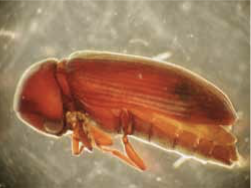
Broad-diet anobiid powderpost beetle
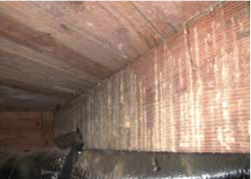
Visual evidence (frass streaming from exit holes) of an active anobiid powderpost beetle infestation in a crawlspace joist.
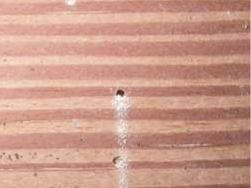
Anobiid powderpost beetle exit holes in an infested crawlspace joist.
True powderpost beetles (Bostrichidae: Lyctinae: principally Lyctus spp.): Adult beetles 1/8 to 3/16 in., cigar shaped, brown to black, with 11-segmented antennae where the last two segments are enlarged and form a club. Habits: True powderpost beetles infest hardwoods only; they will also infest bamboo. Most commonly reported from hardwood floors less than 5 years old, but can be found emerging from any item made of hardwood. Wood is infested prior to its final use. For example, hardwood floors are infested prior to their installation in the home, and the adults emerge soon thereafter, typically within a year or two of introduction into the home. The best evidence of an active infestation is round holes in wood (1/16 in. diameter) surrounded by frass (or streaming from the hole) the consistency of baby powder and a beetle identified by an entomologist. Can re-infest susceptible hardwoods, and do considerable damage, if conditions are favorable (successful mating and the availability of an unfinished hardwood surface). They do not infest structural wood (softwoods), such as pine or fir, so will not spread from infested items to become a structural pest. Interventions:Replacement of infested wood (for example, individual planks in a hardwood floor) is the best option. Might Be Confused With: sawtoothed grain beetle, flour beetle, other small beetles.
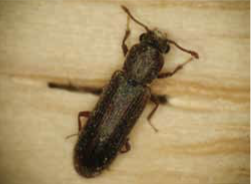
True powderpost beetle
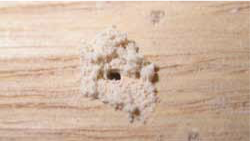
True powderpost beetle frass and exit hole in an oak shelf.
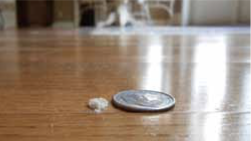
Frass from a true powderpost beetle emerging from hardwood flooring.
False powderpost beetles (Bostrichidae excluding Lyctinae: many species): The most commonly encountered false powderpost beetles are 1/8 to 3/8 in., elongate and cylindrical, stout, and black to reddish brown. The head is not visible from above, but is hidden from view by a large, hood-like pronotum (upper thorax) with stout, cuticular spines along the rounded front edge. False powderpost beetles have short, serrate antennae with the terminal three to four segments enlarged (club-like). Elytra often end in distinct spines. Exit holes range in size, depending on beetle species. Exit hole size overlaps with exit hole size made by both true powderpost beetles and anobiid powderpost beetles, but larger false powderpost beetles leave large, round exit holes larger than any hole left by a true powderpost beetle or an anobiid powderpost beetle. Habits:False powderpost beetles are less economically important than either true powderpost beetles or anobiid powderpost beetles. They can infest rough cut lumber where strips of bark have been left intact. Unlike true powderpost beetles and anobiid powderpost beetles, adult female false powderpost beetles burrow into the wood where they deposit their eggs; true powderpost beetles and anobiid powderpost beetles lay eggs on the outer surface of the wood. False powderpost beetles attack both hardwoods (preferred) and softwoods that have a high moisture content (i.e., newly cut wood). May also infest pithy plants used in dried floral arrangements such as grapevine wreaths. Also attack wicker. Can re-infest, but not wood that has seasoned and dried considerably (to less than 10% moisture) since the initial infestation. Re-infestation is uncommon because aged wood is considerably drier than newly cut wood. Interventions: Ensure that bark strips are removed from freshly cut wood. Apply products containing the active ingredient disodium octaborate tetrahydrate (DOT) to prevent re-infestation, fumigate, freeze or remove the infested material. Might Be Confused With: anobiid and true powderpost beetles, ambrosia beetles.
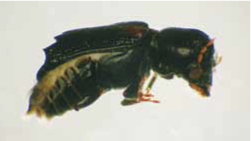
False powderpost beetle
Drugstore beetles (Anobiidae: Stegobium paniceum): Small, 1/8 to 3/16 in., light brown beetle with antennae ending in three broadened segments. Head concealed by helmet-like pronotum (upper thorax) and elytra with longitudinal rows of pits. Habits:This somewhat common stored product pest consumes items in the home of animal and plant origin (dried foods in the pantry, dog treats, etc.). Interventions: Find infested item(s) and discard. Clean up spilled food. Store potentially susceptible items in tightly sealed containers. Never treat human food sources with an insecticide. For more detailed information see University of Georgia Extension Bulletin 1378, Stored Product Pests in the Home, at caes.uga.edu/publications. Might Be Confused With: other beetle pests of stored products, anobiid powderpost beetles.
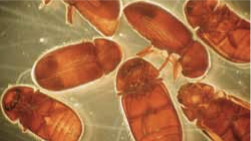

Drugstore beetles and antennae (inset)
Carpet beetles (Dermestidae: Anthrenus spp.): Adults are 1/16 to 1/8 in., oval-shaped, and calico colored. Larvae are 1/8 in., hairy, oval-shaped, slow-moving, and cryptic. Habits: Most homes are populated by a small number of carpet beetles, but because they are somewhat cryptic (slow moving, small, and inconspicuous) they are rarely seen. Larvae, but not adults, feed on products in the home that are of animal origin (feathers, wool, fur, hair, silk, skins, dry animal food, etc.) but will also feed on dead insects (found on window sills, in wall voids, and in light fixtures). Carpet beetles do not consume modern shirts and carpets, as they are made from cotton or synthetic fibers. Adults feed on pollen outdoors. Interventions: Find infested article(s) and remove. Vacuum insects and discard bag, and especially watch for re-infestation. Wash, steam-clean or dry-clean all items of animal origin, especially wool. Have infested textiles professionally cleaned. If desired, apply a spot treatment with an appropriately labeled residual spray to the floor around the infested item(s). Might Be Confused With: warehouse beetle (Dermestidae: Trogoderma variabile), bed bugs.
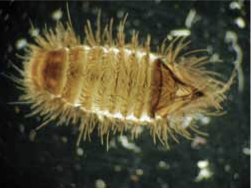

Carpet beetle larva and adult (inset)
Ground beetles (Carabidae: many species, especially Harpalus spp.): Numerous species, 1/4 to 1 in. Common species are black—some shiny, some dull or flat black. One species, called the caterpillar hunter, is an iridescent green, 1 in. ground beetle. Hardened elytra, often with visible, longitudinal furrows or pits. Many species with strongly serrated mandibles, indicative of a predatory insect. Habits: Fast-crawling, highly beneficial predators of other insects. Some species are attracted by insects that have been attracted to exterior lights. Harbor in log piles, leaf litter, and under flat items, such as boards, lying on the ground. Ground beetles are strongly attracted to lights. Interventions: Follow suggestions under section titled Proactive Pest Management. It is especially important to eliminate harborage, install doorsweeps, and alter lighting. Ground beetles are highly beneficial, predatory insects. Attempts should be made to conserve them. However, if desired apply a spot treatment with an appropriately labeled residual spray directly to beetles (spray only outdoors). Might Be Confused With: cockroaches, other similarly sized beetles.

Ground beetle
Multicolored Asian Lady beetles (Coccinellidae: Harmonia axyridis): Also referred to as ladybugs or ladybird beetles. Oval-shaped, 1/4 in., black and white thorax with or without black spots on red or orange elytra. Common insect in gardens. Habits: Highly beneficial, predatory beetle as adults and larvae, mostly of aphids and scale insects. Become nuisance in the fall when they begin searching for overwintering sites inside homes and other structures. Interventions: Follow suggestions under section titled Proactive Pest Management. It is especially important to make sure all windows are screened, that doors remain closed, and doorsweeps are installed on all exterior doors. Before lady beetles begin to seek refuge indoors (fall), take action to (1) seal all cracks 1/8 wide or wider, and (2) spot spray around all potential entry points with an appropriately labeled residual spray. Reapply insecticide treatments, per label specifications, through the end of November/early December. Interventions should be implemented early enough (mid-September) so that preventative measures are in place before the onset of lady beetle migration indoors. If lady beetles get inside the best solution is to vacuum them. Insecticide treatments indoors are not recommended. If lady beetles die inside walls or in attics their carcasses accumulate and may attract other insects that eat them, especially carpet beetles. It is often best to seek help and advice from a pest management professional experienced in lady beetle control. For more information see the publication, Multicolored Asian Lady Beetle. Might Be Confused With: kudzu bugs, brown marmorated stink bugs, boxelder bugs.
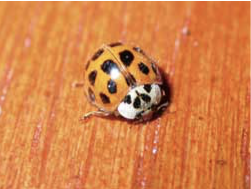

Multicolored Asian Lady beetle adult and larva (inset)
Lesser Mealworm beetles (Tenebrionidae: Alphitobius diaperinus): Also referred to as litter beetles or darkling beetles. Adults small (1/4 in.), broadly oval, moderately convex, black or brownish black shiny beetles with longitudinal grooves on the elytra. Antennae with increasingly larger segments; each antennal segment round. Habits: Often associated with chicken litter. Adults are attracted to lights and are strong fliers; able to fly long distances from site of origin. Found on products already damaged by molds. Interventions: For homes with constant pressure (such as homes near chicken production areas or near agricultural fields where chicken litter is spread), exclusion is generally best. Take action to seal all cracks 1/8 wide or wider. It is especially important to make sure that all windows are screened, that doors remain closed, and that doorsweeps are installed on all exterior doors. Follow suggestions under section titled Proactive Pest Management. Using yellow light to decrease attraction may also help. If desired apply a spot spray, around all potential entry points, with an appropriately labeled residual spray. Might Be Confused With: ground beetles.
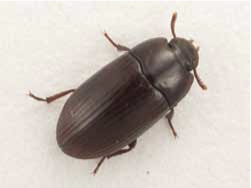
Lesser Mealworm beetle
Sawtoothed Grain beetles (Silvanidae: Oryzaephilus surinamensis): Very small (1/16 in.), slender, dark brown beetle with characteristic teeth along each side of the prothorax. Habits: One of the most common pests of stored products in the U.S. Infests common foods in pantries and food closets. Mostly crawls, rarely flies, and can be long-lived. Interventions: Find infested food (cereal, bird food, crackers, oatmeal, etc.) and discard. Clean up spilled food. Store potentially susceptible items in tightly sealed containers. Never treat human food sources with an insecticide. For more detailed information see University of Georgia Extension Bulletin 1378, Stored Product Pests in the Home, at caes.uga.edu/publications. Might Be Confused With: true powderpost beetles, flour beetles.
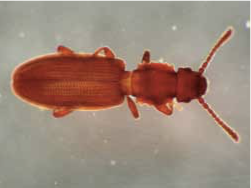
Sawtoothed Grain beetle
Sugarcane beetles (Scarabaeidae: Euetheola humilis): Oblong- to oval-shaped, 1/2 to 5/8 in., flat or shiny black to brownish black robust beetle with longitudinal rows of slight indentations on hairless elytra. Large, strong, spiny forelegs for digging. Habits: One or two population peaks (spring and late summer [August]) per year. Beetles may be very numerous when present. Short-lived adults strongly attracted to lights at night. At sunrise adults attempt to burrow away from sun no matter where they are, sometimes resulting in damage to roof shingles, pliable rubber caulking and sealants along expansion joints, expansion papers, etc. Interventions: Turn off lights during peak flight times, change to yellow lights, or use flood lights, positioned away from but pointing towards the building, to attract beetles away from the building. If desired, apply a spot treatment with an appropriately labeled residual spray to areas beetles aggregate, such as in corners and along seams where horizontal and vertical surfaces meet. Might Be Confused With: numerous other black scarab beetles, ground beetles.

Sugarcane beetle
White-fringed beetles (Curculionidae: Naupactus leucoloma): Longitudinally striped light to dark brown beetle, 1/4 to 3/8 in., with a somewhat distinct beak (rostrum) and elbowed antennae. Habits: Larvae feed on roots of grass, and some agricultural crops, followed by punctuated adult emergence in summer, sometimes in large numbers. Can be especially numerous near agriculture fields. White-fringed beetle activity is seasonal and predictable in occurrence. Interventions: Problems often cease on their own, so that insecticides are not needed. Follow suggestions under section titled Proactive Pest Management. It is especially important to install doorsweeps. If desired, apply a spot treatment with an appropriately labeled residual spray directly onto beetles (spray only outdoors). Might Be Confused With: other weevil species, ground beetles.
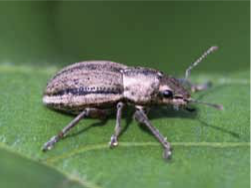
White-fringed beetle
Wood-boring beetles (Cerambycidae and Buprestidae: many species): Wood-borer is a general term that refers to the larval form of beetle species in either the family Cerambycidae or Buprestidae. They infest both hardwoods and softwoods. Adult cerambycids (called longhorned beetles) are elongate, cylindrical and 3/8 to 1 in., often with antennae as long or longer than the body. Larvae are referred to as roundheaded borers. Adult buprestids (called metallic wood-boring beetles) are 3/16 to 3/4 in., bullet shaped, often metallic blue and/or emerald green. Larvae are referred to as flat-headed borers. Because adult beetles are rarely seen or found, diagnosis of infestation in wood is usually dependent upon the morphology and size of the exit hole made by the adult beetle after it emerges from the wood. Longhorned beetle exit holes are nearly round to slightly oval, with a 1/8 to 3/8 in. long diameter (the long-diameter is never more than twice the short-diameter), while metallic wood-boring beetle exit holes are elongated, flattened ovals with a 3/16 to 1/4 in. long-diameter (the long-diameter is approximately three to four times the short-diameter). Habits: Wood-borers infest wood soon after the tree is felled, but before bark is removed. They cannot infest seasoned, processed lumber (in lumberyards or dimensional lumber in service) or trees that have been debarked. Infestations are more common in wood cut from one’s own property, but not kiln-dried or debarked quickly enough. They can also infest rough cut lumber where strips of bark have been left intact. Following mating, females lay eggs on the bark. Eggs hatch, and larvae burrow into and begin feeding just under the bark. They then move to the sapwood where they will remain for several years, until emergence, while consuming the wood. For various reasons, larvae may survive the milling process and are then built into structures using infested wood (structural lumber or logs for log homes). Adult wood-borers most often emerge from wood 1–3 years after construction. Generally, development time is quicker in wood with elevated moisture (logs), and can be delayed by several years in dry or drying wood (dimensional lumber). Exit holes are the result of the adult beetle chewing its way out of the wood to free itself to the outside. When beetles emerge, they are looking for a mate and then must find a tree with bark on it. Like the powderpost beetles, when adult wood-borers emerge from the wood they emerge perpendicular to the wood’s surface. Active infestations are characterized by frass (beetle excrement) streaming from the hole. Exit holes with no frass present are evidence of a prior infestation, but not necessarily one that is still active. Interventions: None needed as these beetles will not re-infest, unless the wood contains moisture and has bark present and females are successfully mated. Beetle emergence holes are an aesthetic problem. The feeding damage done by larvae is not known to compromise the structural integrity of the wood. Generally, seek help from a professional pest control company to determine (a) beetle identification, (b) whether the infestation is active or not, and (c) options for control, if needed. Obtain help with positive beetle identification from an entomologist. Control recommendations are entirely dependent upon beetle identification and infestation status. Might Be Confused With: old house borer.
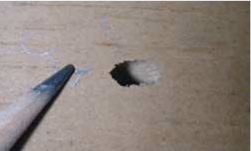
Wood-boring beetle exit hole
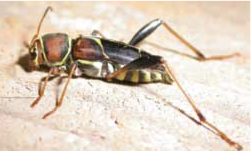
A longhorned beetle
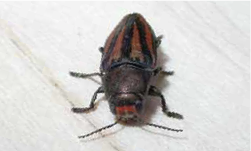
A metallic wood-boring beetle
Old House borer (Cerambycidae: Hylotrupes bajulus): Diagnosis of an Old House borer (OHB) infestation is typically based on: (a) exit hole morphology (exit holes elongated, flattened ovals 1/4 to 3/8 in. with a long-diameter never more than twice the short-diameter); (b) frass (a fine powdery texture where individual pellets are barrel-shaped); and (c) ridged galleries made by larval feeding. When larvae can be obtained, they can be identified by the presence of three ocelli (eyes), in a row, on the head. Larvae can sometimes be heard chewing in the wood. Adults are rarely seen, but are elongated (5/8 to 1 in.), somewhat flattened, brownish black beetles with moderately long antennae (at least 1/3 the length of the body). Margins of pronotum (upper thorax) covered with numerous gray to white, short hairs. The center of the pronotum is naked, and contains two knobs that appear eye-like. Habits: The OHB feeds only on softwoods (mostly pine) and it prefers wood less than 10 years old with a moisture content greater than 10%. It is a species of wood-boring beetle in the family Cerambycidae (see section above on wood borers). It is not native to the U.S. It is singled out here because unlike the other wood-borers in North America it can infest seasoned, dimensional lumber (at the lumber yard) before it is used in construction; like other cerambycids, it can also attack recently felled, barked or debarked, trees. Most OHB infestations are built into structures by using previously infested softwoods (i.e., construction materials, pine floors, log homes) during construction. What makes the OHB different is that if conditions are favorable (successful mating upon emergence from infested wood and then location of a softwood with an adequate moisture content), it can then infest and continue to re-infest structural softwoods in the home. In contrast, the wood borers (mentioned above) cannot. Because they are built into homes, detection of OHB infestations is most typical in structures that are less than 10 years old. Development time (egg to adult emergence from wood) is strongly dependent upon wood moisture. Under the most favorable conditions (wood moisture content 15 to 25% [for example, logs in a new log home]), beetles can develop in 2–5 years, but development may take up to 10 to 15 years in exceptionally dry wood (wood moisture content less than 10% [for example, dry (and drying), seasoned dimensional lumber]). The senior author of this bulletin once acquired a piece of OHB-infested pine flooring (age unknown) and an OHB adult emerged from it 5 years later. Even though OHBs can infest susceptible wood in the home, survival of first instar larvae is low in wood with exceedingly low moisture content (less than 10%). Because of changes in wood-handling procedures over the past few decades, incidence of OHB infestations in homes has declined dramatically. Although the vast majority of OHB infestations found in the home do not result in spread into other structural softwoods, the initial infestation (built into the structure) can do considerable damage to structural softwoods prior to adult emergence. When an OHB emerges, it must find a mate, successfully mate, and then the female must find a piece of susceptible softwood—i.e., wood with a moisture content greater than about 10%. Interventions: Application of products containing the active ingredient disodium octaborate tetrahydrate (DOT) to the surface of lumber can act as a deterrent to infestation and re-infestation. Localized treatment of active infestations or wood replacement, if possible, are other options. Fumigation should be considered for widespread infestations. Consult with a pest management professional in severe infestations. Might Be Confused With: many other species of wood borers in the family Cerambycidae and Buprestidae.
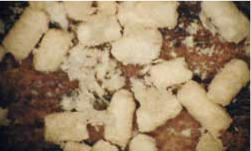
Old House borer larval fecal pellets (frass) are barrel-shaped.
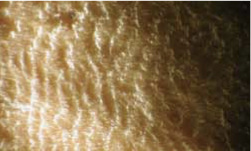
Evidence of Old House borer larval feeding (ridges in the gallery).
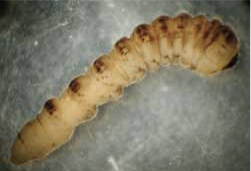
Old House borer larva

Head of Old House borer larva (3 ocelli, blue arrow).
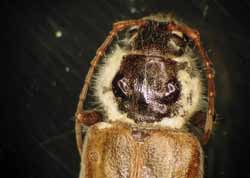
Old House borer beetle
Moths (Order Lepidoptera)
Species of Lepidoptera are characterized, in part, by the scales covering four wings and by a proboscis, or sucking mouthparts. Moths, and particularly their larvae, are major agricultural pests in many parts of the world.
Clothes moths (Tineidae: Tineola and Tinea spp.): Shiny, light gold-colored, 1/4 in. moth with fringed wing margins. The most common species in Georgia is the casemaking clothes moth (Tinea pellionella). Larvae of casemaking clothes moths build rectangular to elliptical cases about 1/4 in. that are open at both ends and spun from materials and/or fibers in their immediate environment,
often fibers they have been feeding on. Larvae live, protected, inside the case. Larvae have a dark band just behind their head, which is visible only when the larva projects its head out of the case to feed. Habits: Moths fly at night, usually in an erratic pattern, in search of mates and food. Adults lay eggs on items of animal origin, commonly feathers and wool. Larvae crawl around and on the item while feeding from inside their case. In preparation for pupation, larvae of the casemaking clothes moth crawl away from the item they are infesting and attach their case to the wall or other nearby vertical surface. Interventions: Wash, steam-clean or dry-clean all items of animal origin, especially wool. Have infested textiles professionally cleaned. If items cannot be washed or steam-cleaned (large quantities of material, such as area rugs) then consider small-scale fumigation or storage for at least a month in a freezer. Before cleaned items are put back in the home, remove, by hand, visible pupal cases from vertical surfaces and from shelves. Consider storing susceptible fabrics in sealed containers to prevent re-infestation. Use pheromone traps to capture male moths. If desired, apply a spot treatment with an appropriately labeled residual spray to the area where moths and larvae are found. Might Be Confused With: Indianmeal moths; other, small, incidental moths that fly indoors, from outdoors, when doors are open.


Casemaking clothes moth larva eating wool carpet, and adult (inset).
Indianmeal moths (Pyralidae: Plodia interpunctella): Half copper and half tan-colored wings. Indianmeal moths are about 3/8 to 1/2 in. Habits: The most common pest of stored products in the U.S. Infests common foods (especially hot and cold cereals) in pantries and food closets. A very common pest of birdseed. Flies at night in search of mates and food. Interventions: Find infested material (cereal, bird food, crackers, oatmeal, etc.) and discard. Clean up spilled food. Pheromone traps capture only male insects. Store potentially susceptible items in tightly sealed containers. Never treat human food sources with an insecticide. For more detailed information see University of Georgia Extension Bulletin 1378, Stored Product Pests in the Home, at caes.uga.edu/publications. Might Be Confused With: clothes moths; other, small, incidental moths that fly indoors, from outdoors, when doors are open.
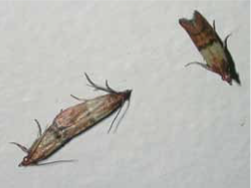
Indianmeal moths
Flies (Order Diptera)
Adult flies are recognized by two functional front wings and by two small structures, called halteres (modified hind wings), that are club-shaped and probably function in a flight-balancing manner. This group of insects is good at, as their common name suggests, flying. Therefore the best interventions are aimed at finding and eliminating the larval (immature, non-flying stage) feeding sites. The larvae of most pest species leave the feeding site and ‘wander’ some distance from their food source (usually wet conditions) to pupate (usually dry conditions). Proper sanitation is the key to pest fly management. Remove garbage and other refuse at least twice per week to avoid fly problems.
Crane flies (Tipulidae): Crane flies have long legs, a long slender body, and vary in body length from 1/16 to 1 in. Some crane flies may resemble large mosquitoes. Color will vary depending on species, but one common species is light brown or tan. The larvae are called leatherjackets and can damage lawns by feeding on the roots of grass. Habits: Crane flies generally rest with their legs spread widely. Adults feed on nectar or do not feed at all; many have vestigial mouthparts. Once they become adults, most crane flies simply mate and die, all within a few days. They do not bite humans. Interventions: No action recommended. Might Be Confused With: mosquitoes.
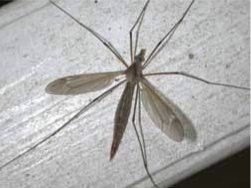
Crane fly
Fruit flies (Drosophilidae): The most common species have red/orange eyes, but not all fruit flies have red/orange eyes. Fruit flies often hover around and just above food (most often decomposing vegetable matter) prior to landing. Flies are 1/8 in. Habits: Feed mainly on decaying vegetable matter, compost, rotting fruit, etc. Often found around salad bars and restaurants where vegetable matter and juices collect. Also called vinegar flies, since vinegar (acetic acid) is a decomposition product of some rotting vegetable matter. Interventions: Find larval fly feeding site(s) and clean or otherwise throw away rotting fruit or vegetable matter. Remove garbage, including the plastic liner, and other refuse at least twice per week. Might Be Confused With: humpbacked flies, fungus gnats, moth flies.
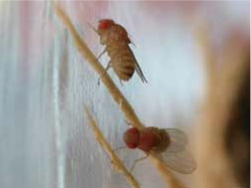
Fruit flies
Fungus gnats (several families represented; mostly Sciaridae): Small (1/16 in.) fly with smoky black wings. Y-shaped wing venation is characteristic. Habits: Often found in overwatered plants indoors or in otherwise wet conditions.Interventions: Find larval fly feeding site(s) and clean or otherwise dry out. If desired, apply a soil drench with an appropriately labeled liquid insecticide. Might Be Confused With: mosquitoes, fruit flies, humpbacked flies, moth flies.
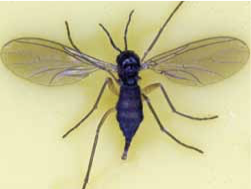

Fungus gnat and Y-shaped wing venation (inset).
Black Soldier flies (larva) (Stratiomyidae): Strongly segmented larva, 3/4 to 1 in., with two 1/16 in. protrusions from one end. Adult flies rarely seen, but are 3/4 in. and appear wasp-like and with two clear spots on upper abdomen. Habits: In homes, larvae usually found in the bathroom. Presence in bathroom may be indication of sanitary (sewer drain or septic tank) problems because larvae feed in putrid, wet conditions. This insect also lays eggs and larvae develop in piles of damp organic matter such as compost piles. Like many fly species, larvae are known to wander well away from their breeding site into areas where they pupate. Interventions: Find the larval food source and address the problem by sanitation or moisture management. Might Be Confused With: adults look like wasps.
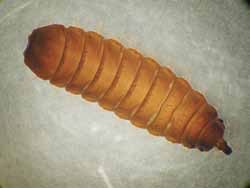
Black Soldier fly larva
House flies (Muscidae: Musca domestica): The most recognizable of all fly species. Black, drab, 1/4 in., fast-flying, often numerous around garbage cans and related refuse areas. Habits: Breeds in garbage, trash, animal waste, and other organic refuse. Like most flies, found most frequently breeding in overly liquid or wet conditions. Often associated with unsanitary, unkept conditions, such as areas abundant in animal waste or human garbage/landfills. The term maggot is most commonly used in reference to this fly’s larval stages. Because flies are pushed by prevailing, local winds, their source may be from some distance away. Interventions: Proper sanitation and exclusion is an effective means of reducing fly numbers. Indoors deploy and maintain sticky traps associated with attractive lights (commercial insect light traps) and/or the chemical attractant Z-9-tricosene. Be sure that indoor light traps are situated so that they cannot be seen by flies from the outside. There is no scientific evidence to support claims that a hanging bag full of water serves as a deterrent to house flies. Remove garbage and other refuse at least twice per week. Might Be Confused With: blow flies.
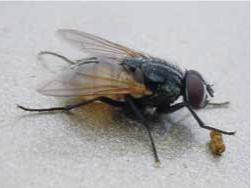
House fly
Humpbacked flies (Phoridae): Also referred to as scuttle flies or coffin flies. Often scuttle about on the surface around and on infested materials. Humpbacked flies are about 1/8 in. Habits: Often associated with dead and decaying animal or plant matter (e.g., dead insects, rotting potatoes), bacterial buildup in drains (drain and sewer scum) in bathrooms and kitchens, and in/around garbage cans. Interventions: Find and clean fly breeding site(s) and/or clean out drains. Make certain that the water trap in the drain line (especially common in less frequently used sinks) is filled—if the water trap dries out, flies and other pests that live in the drain lines will be able to enter the building. Remove garbage and other refuse at least twice per week. Might Be Confused With: fruit flies, moth flies, fungus gnats.
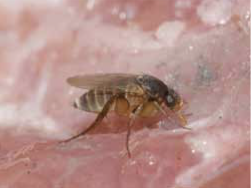
Humpbacked fly
Midges (Chironomidae): Visual appearance similar to mosquito. Males with long, feathery antennae. Habits: Most often associated with eutrophic, polluted lakes or other bodies of stagnant or polluted water. Does not bite. Moreover, adults are short-lived and do not feed. Strong attraction to lights. Often emerges in large numbers and is attracted to light-colored surfaces, such as the sides of nearby buildings with bright lighting. Interventions: Keep lights off during mass emergences. If desired, apply a spot treatment with an appropriately labeled residual spray to the side of buildings where midges are most abundant. Control of larvae in nearby bodies of water must be conducted by a licensed professional. Never apply a pesticide to or around any body of water. Might Be Confused With: mosquitoes.
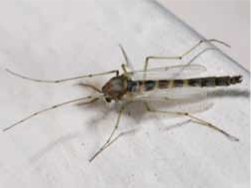
Midge
Blow flies (Calliphoridae: many species): Also referred to as bluebottles and greenbottles. Large, robust, fast-flying flies, 1/4 to 3/8 in., commonly shiny and with metallic blue, green, copper, or gray coloration. Some species strongly bristled, some with stripes on their pronotum (upper thorax), and some with large, reddish-brown eyes. Resemble house flies in their flying behavior. Habits: Flies attracted to and breed in recently dead and decaying animals and animal waste. When suddenly present in large numbers, and when present indoors (typically at windows sills), is highly suggestive of a dead animal indoors (e.g., attic, crawlspace, wall void, fireplace, etc.). Interventions: Find dead animal and remove it. Maintain window and door screens to prevent entry into the house. Remove garbage and other refuse at least twice per week. Might Be Confused With: house flies (especially the maggots).
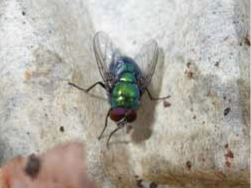
Blow fly
Mosquitoes (Culicidae): Delicate, long-legged, 1/8 to 1/4 in. flying insect. Distinct buzz from flying mosquitoes is the sound of their wing beat. The Asian Tiger mosquito (Aedes albopictus), one of 60-plus mosquito species in Georgia, has distinct black and white legs, while other species are dull brown. Habits: Female mosquitoes bite because they require blood to produce the protein needed for egg production. Males of most species feed on nectar from flowers. Like other blood-feeding arthropods (ticks, fleas, and bed bugs), mosquitoes are attracted to carbon dioxide, as it is indicative of a warm-blooded host. Some people are indeed more attractive to mosquitoes due to chemicals on the skin that make them more attractive than other people. Mosquitoes require standing water for larval development. The adults are common in shaded, wind-protected areas with abundant vegetation (low growing ground covers and tall grass). Many human-biting species are most active at dusk and dawn. Interventions: The larval stage (wriggler) is least mobile and most vulnerable stage to any management strategy. Eliminate standing water, clean gutters and remove containers that can hold rainwater. Follow recommendations in the section Proactive Pest Management. Apply floating briquettes that contain Bti (Bacillus thuringiensis subsp. israelensis) to kill the larvae in standing water. When outdoors use a repellent to discourage biting by female mosquitoes (males do not bite). See EPA website on repellents at cfpub.epa.gov/oppref/insect. For more information see University of Georgia Extension Circular 782, Stinging and Biting Pests, at caes.uga.edu/publications. Might Be Confused With: midges, crane flies.
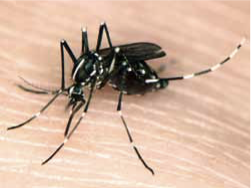
Asian Tiger mosquito
Drain flies (Psychodidae: Psychoda spp.): Also referred to as moth flies. Oblong or oval, appears moth-like, and is about 3/16 in., wings fuzzy. Larvae up to 3/8 in. Habits: Commonly found in bathrooms (breeds in scum in drains, showers, overflows, toilet bowls, etc.). Adults rest motionless on walls until disturbed, and then fly well. Need wet conditions to breed. When toilets have gone unflushed for an extended period, moth flies may lay eggs in the toilet tank, and larvae can be found there. When the toilet is finally flushed, larvae can make their way into the toilet bowl, where they are discovered. Interventions: Clean the inside of the drain of all scum and detritus using a mild cleanser and a bristled brush. Never pour insecticides into drain. Pouring bleach into drains is not effective. Make certain that the water trap in the drain line (especially common in less frequently used sinks) is filled—if the water trap dries out, flies and other pests that live in the drain lines will be able to enter the building. To help determine whether a particular drain is infested, place a clear cup, inverted, over the drain. If flies emerge from the drain, they will be trapped by the cup, and can be seen. Might Be Confused With: fungus gnats, humpbacked flies, fruit flies, and small moths.
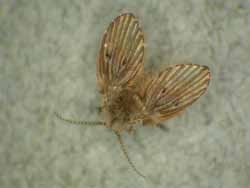
Drain fly
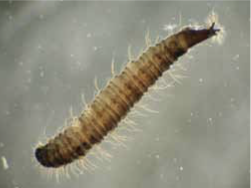
Drain fly larva
Ants, Bees, and Wasps (Order Hymenoptera)
This group of insects contains some of the most beneficial insects known. Besides the honey bee, the Hymenoptera also contains many species that are parasites and predators of highly destructive insect pests. However, there are also Hymenoptera that are considered pests. Some sting and can create a life-threatening medical condition called anaphylaxis in people allergic to that particular venom. Generally, all mature, adult members of this Order have four membranous wings, with the hind wings smaller than the front wings.
Ants
All ants belong to the family Formicidae. It is important to correctly identify the type of ant involved in an infestation because of the diversity of lifestyles represented by this group of insects. Interventions that include insecticidal baits are most effective against ants because of their social nature (no one has trouble with an ant, but with many ants), so the main target of an ant management program should be the nest. Ant social structure involves sharing food so it is often simplest to feed ants insecticidal bait and let them carry it back to the nest rather than spending time trying to locate the nest(s).
Acrobat ants (Crematogaster spp.): All worker ants in colony same size and about 1/8 to 3/16 in., shiny black to brown. Abdomen distinctively heart shaped. Ants often walk with abdomen projected into air at 45 degree angle. Habits: Acrobat ants commonly trail onto buildings from trees via branches and overhead power and telephone cables that touch the building. Ants commonly nest in foam board insulation, leaving insulation dust on areas directly below the nest site and which reappears after it is cleaned up. Debris from acrobat ant nest sites often contains bits and pieces of uneaten insects that have been only partly consumed, dead acrobat ants from the colony, and pieces of sawdust and/or insulation the ants have chewed. Interventions: Cut limbs away from structure. Bait (liquid and/or gel bait) where ants are found foraging. If baiting is not successful, apply a spot treatment with an appropriately labeled residual spray where ants are found (outdoors only), especially on tree trunks and limbs. Might Be Confused With: other, similarly sized ants.

Acrobat ants
Argentine ants (Linepithema humile): All worker ants in colony the same size and about 1/8 in., light brown. Fast-crawling. Habits: Primary nuisance ant pest in Georgia. Long, well-established trails visible during summer. Colonies large, containing tens of thousands of ants. Nest mainly outdoors, in mulch and leaf litter, while foraging into the canopy of trees. Can be difficult to control in Winter, as it moves indoors to escape cold temperatures. Not native to the U.S. Sometimes referred to as sugar ants. Interventions: Bait (liquid and/or gel bait and/or bait stations) both indoors and outdoors at the same time if ants are found in both areas. Place baits where ants are found foraging. In addition to baiting, reduce mulch and extensive ground covers and vegetation around the foundation. Follow recommendations under section Proactive Pest Management. If baiting and cultural practices do not provide relief, apply a spot treatment with an appropriately labeled residual spray around windows, doors, and nest sites where ants are found. For more information see University of Georgia Extension Circular 926, Argentine Ants, at caes.uga.edu/publications. Might Be Confused With: other, similarly sized ants, especially the odorous house ant.

Argentine ants
Black Pyramid ants (Dorymyrmex smithi): Dull black, 3/16 in., slender, very fast moving ant with a pyramid-shaped projection on its thorax. All worker ants in colony are the same size. Crawling behavior characterized as fast, erratic, and seemingly random. Habits: Found outside mainly in sandy, well-drained, dry habitats. When present, ants can be so numerous that they are seemingly everywhere. Do not bite or sting, but may quickly overcome any item, animate or inanimate, placed on the ground. Reach peak population size in July and August in Georgia. Entrances to nest sites are single holes in the ground at the bottom of a funnel-shaped depression in the typical sand habitat. Interventions: If desired, apply a perimeter treatment with an appropriately labeled residual spray around the foundation of the structure. Treat grassy areas around entire perimeter of structure. Might Be Confused With: other, similarly sized ants, such as fire ants and Argentine ants.
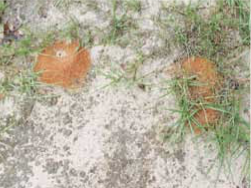

Black Pyramid ant mounds and adult (inset)
Black Carpenter ants (Camponotus pennsylvanicus): Worker ants from the same colony vary in size (1/4 to 1/2 in.) and are dull black with small gold hairs on the abdomen. The largest of Georgia’s pest ants. Habits: Carpenter ants live primarily in knotholes in large hardwood trees. They are nocturnal, and forage along permanent trails from nest sites to feeding sites. Indoors, found in dishwashers, under insulation, and sometimes in moisture-laden wood. Interventions: At night, when ants are most active, provide them bait, especially gel bait. Do not use bait stations. Apply bait on active trails, or in a location where ants are found. For more information see University of Georgia Extension Circular 929, Carpenter Ants, and Bulletin 1225, Biology and Management of Carpenter Ants, at caes.uga.edu/publications. Might Be Confused With: other, similarly sized ants, such as mound ants.
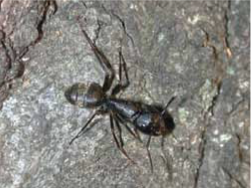
Black Carpenter ant
Red Imported Fire ants (Solenopsis invicta): Reddish-brown workers vary in size (1/8 to 3/16 in.) in a single colony. Habits: Inflicts painful sting. Builds easily distinguishable mounds in sunny, often disturbed habitats (yards, pastures, right-of-ways, parks, playgrounds, etc.). Not native to the U.S. Interventions: Spring through fall, spread bait granules in late afternoon (when temperatures are warm and the ground is dry) to entire yard or sprinkle one handful of bait around (never on top of ) the perimeter of each active mound. Never disturb mound prior to applying bait. Ten to 14 days after bait application, if active mounds remain, treat them by applying an appropriately labeled liquid insecticide (at least 1 gallon of diluted material—the volume is important to reach the deepest part of the nest under the mound) directly to the top of each active mound. For more information see University of Georgia Extension Bulletin 1191, Managing Imported Fire Ants in Urban Areas, and Circular 782, Stinging and Biting Pests, at caes.uga.edu/publications. Might Be Confused With: other, similarly sized ants, especially pyramid ants.
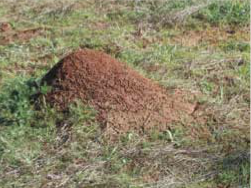
Red Imported Fire ant mound
Mound ants (Formica spp.): Ants in a single colony are different sizes and about 1/4 to 5/16 in. Reddish brown head and thorax and shiny black abdomen. Habits: Colonies are often very large, encompassing acres of land. Ants make permanent foraging trails in grass and sandy areas where they live (commonly oak forest with open understory). Ants commonly pile large quantities of leaf litter and debris around nest sites. These ants do not sting, but are aggressive and will bite while releasing copious quantities of pungent formic acid. In Georgia, generally restricted to the northwest. Interventions: Apply bait that these ants will take. Because ant colonies are large, a large quantity of bait may be needed. If desired, apply a perimeter treatment with an appropriately labeled residual spray next to the structure. Might Be Confused With: other, similarly sized ants, such as carpenter ants.
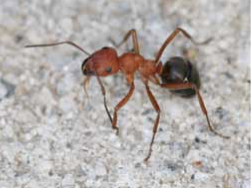
Mound ant
Odorous House ants (Tapinoma sessile): All worker ants in colony are black and the same size (about 1/8 in.). When crushed, these ants have a pungent odor somewhat like sun tan lotion. Habits: A moderate to major nuisance ant pest, more moisture dependent than most other ant pests. This ant nests mainly outdoors, in areas where moisture is abundant (heavy ground cover, mulch, ivy, etc.). Interventions: Bait (liquid and/or gel bait and/or bait stations) both indoors and outdoors at the same time if ants are found in both areas. Place baits where ants are found foraging. In addition to baiting, reduce mulch and extensive ground covers and vegetation around the foundation. Follow recommendations under section Proactive Pest Management. If baiting and cultural practices do not provide relief, apply a spot treatment with an appropriately labeled residual spray around windows, doors, and to nest sites where ants are found. Might Be Confused With: other, similarly sized ants, such as Argentine ants.
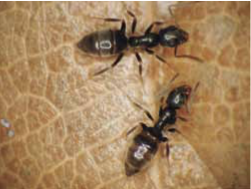
Odorous House ants
Dark Rover ants (Brachymyrmex patagonicus): Black or dark brown ants with round abdomen. Workers from the same colony are all the same size (1/16 in.). This ant is one of the smallest of the pest ants in Georgia. Habits: Feeds on honeydew in the canopy of trees. Not native to the U.S. Interventions: Bait (liquid and/or gel bait and/or bait stations) both indoors and outdoors at the same time if ants are found in both areas. Place baits where ants are found foraging. In addition to baiting, reduce mulch and extensive ground covers and vegetation around the foundation. Follow recommendations under section Proactive Pest Management. If baiting and cultural practices do not provide relief, apply a spot treatment with an appropriately labeled residual spray around windows, doors, and to nest sites where ants are found. Might Be Confused With: other, similarly sized ants, such as fire ants, odorous house ants, and Argentine ants.
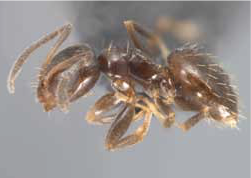
Dark Rover ant
Bees and Wasps
Several groups are represented including honey bees, bumble bees, carpenter bees, yellowjackets, paper wasps, hornets, and various other commonly encountered bees and wasps.
Bumble bees (Apidae: Bombus spp.): Large, black bees (3/4 in.) with bright yellow hairs on the thorax and/or abdomen. Bees from the same colony are different sizes. Habits: Bumble bees are common inhabitants of gardens, where they are most commonly found visiting and pollinating flowers. Highly beneficial. Bumble bees are social, and live in a colony with nest mates. Like yellowjackets, colonies nest in the ground. When their nest is threatened, bumble bees can be aggressive and may sting. Interventions: If the nest is not a threat to the health and welfare of humans, leave it alone as bumble bees are excellent pollinators. If the nest must be eliminated, find the entrance and treat with a labeled insecticide formulated as an insecticidal dust or one of the various wasp and hornet aerosol sprays that shoot their contents up to 20 ft. For more information see University of Georgia Extension Circular 782, Stinging and Biting Pests, at caes.uga.edu/publications. Might be Confused With: carpenter bees, digger bees, yellowjackets.
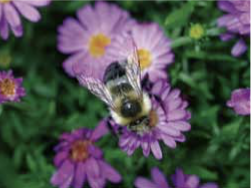
Bumble bee
Large Carpenter bees (Apidae: Xylocopa virginica): Large, black bees (3/4 in.). Appearance similar to bumble bees but with naked, hairless abdomen. Abdomen black to blackish blue. Habits: In Georgia, March–May this bee can be found chewing dime-sized holes in wood boards, logs, etc. It does not eat wood, but chews galleries to create a nest site where eggs are laid. Some bees (males) appear aggressive. Cedar boards are particularly susceptible to extensive damage by carpenter bees. Interventions: Apply an appropriately labeled dust, liquid spray, or jet aerosol directly into carpenter bee holes while bees are active. Begin treatment when bees are first found, and re-treat as needed. In late summer, when all bees have left their nest sites, fill holes with wood filler, sand, and paint (or apply a quality wood finish). Might Be Confused With: bumble bees.
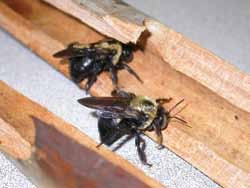
Large Carpenter bees in wood broom handle.
Cicada Killers (Sphecidae: Sphecius speciosus): Large (1 to 1.5 in.), fast-flying, yellow and black-striped, solitary wasp with large eyes. Habits: Although they appear intimidating, wasps are not aggressive. Most active in mid- to late-summer when adults can be found digging holes 1/2 to 3/4 in. diameter in loose soil. Like carpenter bees, patrolling wasps are males (and cannot sting), while females actively search for their cicada prey. Female wasps can sometimes be seen dragging their cicada prey into a hole, on which larval wasps feed. Often moderate to large numbers of wasps aggregate at one site at the same time for the purpose of mating and reproduction. Interventions: The use of mulch (or other ground covers) or improving turf growth and vigor may discourage cicada killers from nesting in these sites in subsequent years. Because these wasps are not aggressive, killing them is not advisable. If desired, apply a spot treatment with an appropriately labeled residual spray or dust formulation into each hole at night when the wasps are resting in the nest. For more information see University of Georgia Extension Circular 782, Stinging and Biting Pests, at caes.uga.edu/publications. Might Be Confused With: hornets, yellowjackets.
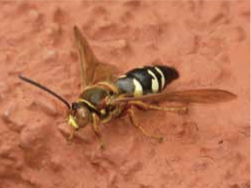
Cicada Killer
Digger bees (Apidae: Anthophora spp.): One common species is a gray-colored bee closely resembling the honey bee, 1/2 to 5/8 in. Females slightly larger than males. Habits: In the spring (March and April), this otherwise solitary bee aggregates, often in large numbers, for the purpose of mating and reproduction. Typical aggregation/ nest sites are barren, grassless ground. When numerous, dozens to hundreds (even thousands) of bees can be seen flying in an erratic fashion approximately 1 ft above the ground. Bees are beneficial pollinators, and not aggressive even at their nest site. Interventions: Digger bees are harmless, and killing them is not recommended. To discourage future nest-site aggregations, barren areas should be covered with mulch or new turfgrass should be planted. Irrigating the area on successive days may cause bees to abandon the location. If desired, apply a spot treatment to aggregation sites with an appropriately labeled residual spray. Might Be Confused With: honey bees.
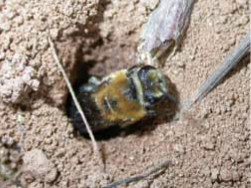
Digger bee
Giant Resin bees (Megachilidae: Megachile sculpturalis): A solitary bee introduced into the southeastern U.S. from Asia. Adult bees large and impressive by their size, 1/2 to almost 1 in.; larger than most native bees in North America. Belonging to a family called leaf-cutter bees. Somewhat resembles carpenter bees. Habits: These bees, generally found around buildings and wooden decks, are opportunistic by nesting in existing wooden cavities. In late summer, sometimes seen entering and occupying vacant carpenter bee tunnels. They do not chew, eat, or otherwise damage wood. Interventions: None needed. Might Be Confused With: carpenter bees.
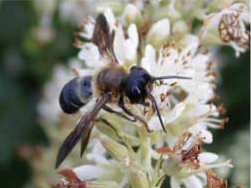
Giant Resin bee
Honey bees (including Africanized honey bee) (Apidae: Apis mellifera):Caramel-colored, 1/2 to 5/8 in., hairy bee sometimes with large accumulations of yellow pollen on their hind legs. Commonly found in gardens visiting flowers while collecting nectar. Africanized honey bees can be differentiated from non-Africanized honey bees only by a professional entomologist. Habits: Honey bees are one of the best known, most recognized and beneficial of all insects. They pollinate billions of dollars worth of crops each year. The Africanized honey bee, a more aggressive and potentially dangerous honey bee, was found in Georgia in 2010. Interventions: The most common problem associated with honey bees is that they sometimes nest inside walls of structures. Do not kill these nests, but call a professional beekeeper or pest management specialist because the bees and honeycomb must be completely removed. Find a beekeeper to remove the bees, then hire someone to remove the honeycomb and replace the wall. All honey bee material and honeycomb residue must be completely removed or secondary pest problems may arise. A carpenter’s skills are often needed. For more detailed information see University of Georgia Extension Circulars 824, Honey Bee Swarms and Bees in Walls, and 782, Stinging and Biting Pests, at caes.uga.edu/publications. Might Be Confused With: yellowjackets, digger bees.
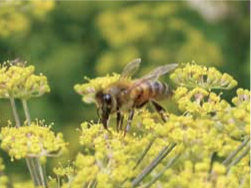
Honey bee
Hornets (Vespidae: Vespa spp.): The European hornet, Vespa crabro, was accidentally introduced into North America about the middle of the 19th century. It is a large eusocial wasp with the wings reddish orange and the petiolate abdomen brown and yellow striped. There are no native hornets in the U.S. Habits: European hornets build large, aboveground nests, usually in trees. Similar to yellowjackets and paper wasps, European hornets build a new nest each year. Each fall all hornets die, with the exception of several queens, which overwinter. The following spring these overwintered, mated queens initiate the construction of a new nest. European hornets are attracted to lights at night. They are not attracted to human foods and food wastes, as are yellowjackets, but they can damage fruits, such as apples, while the fruit is still on the tree. Interventions: If European hornets are found around the house at night, because these wasps will forage after dark and are attracted to lights, examine and change the lighting regime. Do not attempt to remove or treat a nest; call a pest management professional to remove nests near areas of human habitation or activity. For more information see University of Georgia Extension Circular 782, Stinging and Biting Pests, at caes.uga.edu/publications. Might Be Confused With: cicada killers, yellowjackets.
Mud Daubers (Sphecidae and Crabronidae: many species): Long, slender, solitary wasps 1 to 1.5 in., with long, slender waists. Commonly glossy black or blue, some species with yellow highlights. Habits: Builds series of 4- to 6-in.-long vertical mud tubes on walls in areas protected from rain and adverse weather. Commonly found under eaves, decks, etc. Each tube comprised of individual cells housing a single larva and spider prey that wasp larvae feed on. Interventions: Knock down dry mud nests with a broom and wash mud from wall with soap and water. For more information see University of Georgia Extension Circular 782, Stinging and Biting Pests, at caes.uga.edu/publications. Might Be Confused With: paper wasps, potter wasps.
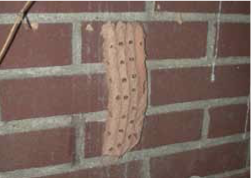
Mud Dauber tubes
Paper wasps (Vespidae: Polistes spp.): Large (1 in.), aggressive wasps when at their nest. Various species, but all build paper-like, multi-celled, inverted umbrella nests under rain- and wind-protected eaves where wasps can enter and exit easily. Habits: Each fall all wasps die, with the exception of several queens, which overwinter in an inactive form in a well-protected, secluded environment such as under and in fallen logs and other ground debris. The following spring, queens initiate and build a small paper nest where they lay eggs. Paper wasps build a new nest each year. Colonies grow and reach peak size in the fall, at which time the cycle repeats. Like other social bees and wasps, paper wasps are aggressive when protecting their nest, and may inflict a painful sting in its defense. Adult wasps are excellent predators in vegetable gardens, and are more docile when not protecting their nest. Interventions: If nests are out of the way, leave wasps alone as they are highly beneficial predators. If desired, spray nest and wasps directly with an aerosol jet spray, or early in the year, before the nest contains too many adult wasps consider knocking down the nest with a long stick but be prepared—and able—to quickly flee the area as the nest is dislodged. Make certain no one in the area is allergic to wasp venom (stings). For more information see University of Georgia Extension Circular 782, Stinging and Biting Pests, at caes.uga.edu/publications. Might Be Confused With: mud daubers.
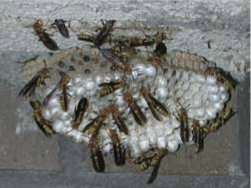
Paper wasps
Potter wasps (Vespidae, but sometimes recognized as Eumenidae: many species): Also referred to as mason wasps. Common species dark blue or black with yellow or white highlights on abdomen and/or thorax. Solitary. Common species 3/4 to 1 in. Strongly sclerotized. Habits: This wasp builds characteristic, oval-shaped (1/2 to 5/8 in. diameter) nests that appear pot-like with a knob-like handle. Pots are ornate and constructed of mud, as if built by a mason. Interventions: Knock down ‘mud pot’ nests with a broom and wash mud from wall with soap and water. Might Be Confused With: mud daubers.
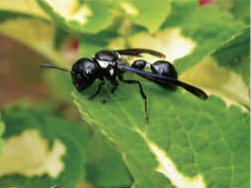

Potter wasp and pot-like nest
Velvet Ants (Mutillidae): Also referred to as cow killer. Black and red, velvety, 1 in., appears ant-like, is fast-crawling, and is rarely at rest. Females wingless, males with black wings. Other species 1/4 in. and orange to red/orange. Habits:Velvet Ants are not ants. They are solitary, wingless, parasitic wasps, and may inflict a painful sting if handled. Never handle or pick up a velvet ant. They commonly parasitize the larvae of other solitary wasps, such as cicada killers. Interventions: Usually these wasps are not so common that extensive chemical control is required. If desired, crush individual wasps or directly spray them with an appropriately labeled aerosol insecticide. Wide scale insecticide treatments are unnecessary. Might Be Confused With: large ants.
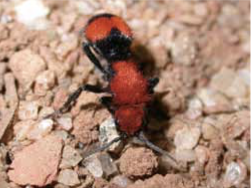
Velvet Ant
Yellowjackets (Vespidae: Vespula squamosa [the Southern Yellowjacket] and Vespula maculifrons [the Eastern Yellowjacket]): Fast-flying, 1/2 in., black and yellow striped, social predators living in colonies containing workers (hundreds to thousands), queens, and males. The Southern and Eastern yellowjackets are the two most common yellowjackets in Georgia. Habits: Yellowjackets nest in the ground and will sting en masse when their nest is threatened. Colony threat typically occurs at nest entrance, where guards are posted, signaling an alarm to all the yellowjackets in the nest (away from the nest, individual yellowjackets are rarely aggressive). Nests are often found by accident as a result of some disturbance near the nest entrance—e.g., while operating a chainsaw, mower, or weed-eater near the nest entrance. Each fall all yellowjackets die, with the exception of several queens, which overwinter under and in fallen logs and other ground debris. The following spring these overwintered, mated queens initiate the construction of a new nest where they lay eggs. Yellowjackets build a new nest each year. Colonies grow through the summer and reach peak population size in the fall, at which time the cycle repeats. Colonies often remain active well into November in Georgia. Interventions: If nests are out of the way, leave yellowjackets alone as they are highly beneficial predators. If desired, treat nest entrance (the hole in the ground) with an appropriately labeled jet-stream aerosol insecticide or insecticidal dust at night when all these day-active insects are in the nest. Make certain no one in the area is allergic to venom (stings). Alternatively, seek help from a pest management professional to remove nests near areas of human habitation or activity. NOTE: A mistake during treatment can result in hospitalization or even death from excessive stings. For more information see University of Georgia Extension Circular 782, Stinging and Biting Pests, at caes.uga.edu/publications. Might Be Confused With: European hornets, paper wasps, honey bees.

Yellowjackets
Minor Orders of Insects – Occasional Pests
Earwigs (Order Dermaptera: Forficulidae): Dark brown to cherry-colored wingless or abbreviated-winged insects with a pair of distinct pinchers on the tail end. Earwigs are 1/2 to 5/8 in. Habits: Typical occasional invader found outdoors in wood piles and under flat items (such as boards) lying on the ground. Also found in heavily mulched areas. Occasionally very numerous. Interventions: Follow suggestions under section titled Proactive Pest Management. It is especially important to eliminate harborage and install doorsweeps. Earwigs are harmless and are simply a nuisance pest. Chemical control is rarely needed. If desired, spray earwigs directly with an appropriately labeled residual spray (spray only outdoors). Might Be Confused With: ground beetles, swarmer termites.

Earwig
Thrips (Order Thysanoptera): Thrips (singular and plural) are very small (1/64 to 1/32 in.), yellow- to tan-colored insects with fringed wings that are only visible under a microscope. Thrips are barely visible to the naked eye. Habits: Thrips are exclusively plant feeders. With their sand paper-like mouthparts, they scrape the surface of plant tissue and drink the juices that flow from the plant wound. Thrips are small enough to pass through standard window screens, and are known to inadvertently bite humans. Interventions: Problems with thrips indoors often subside on their own. Thrips originate from plants, therefore the first step is to remove or move indoor plants to the outside and/or close windows to keep thrips from entering from outside. Might Be Confused With: small, biting flies.

Thrips
Booklice (Order Psocoptera): Booklice, also referred to as psocids, are very small (1/32 in.), usually wingless, whitish insects. Barely visible to the naked eye. Habits: The presence of booklice is an indication of excessive moisture. Booklice feed on microscopic mold and fungi, which grows on substrates such as books, paper, and cardboard housed where humidity is high. Mold and fungi thrive only in environments where humidity is persistent and high. When found, booklice are usually abundant. Interventions: The ultimate remedy, because of the importance of humidity, is dehumidification to reduce moisture in the area. Might Be Confused With: springtails, young bed bugs.
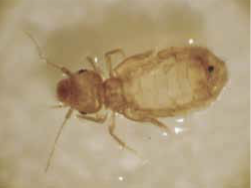
Booklouse
Cat fleas (Order Siphonaptera: Ctenocephalides felis): Wingless, brown, vertically flattened 1/16 in. insects that readily jump. Obligate parasites of warm-blooded hosts. Habits: Although referred to as the cat flea, it is the most common flea associated with cats and dogs. Commonly found on wild animals such as raccoons, opossums, and coyotes, which can serve as the source of pet infestation and re-infestation. As the female flea lays eggs (one per hour), they fall from the animal’s coat and onto the substrate below, where they hatch. As female fleas feed on the pet’s blood some is absorbed but most is passed, where it collects as dried particles in the same location as the eggs (commonly pet resting areas). The newly hatched larvae eat the dried blood, develop through three larval instars, pupate, complete development, re-infest the animal, and the cycle repeats. Adult fleas can remain in the pupal cocoon for months prior to emergence and re-infestation of the animal. Following emergence from the cocoon, adults must find and infest a host within a few days or they will desiccate and die. Adult fleas spend all but the first few days of their life on a warm-blooded host. Like other blood-feeding arthropods (ticks, bed bugs, and mosquitoes), fleas are attracted to carbon dioxide, as it is indicative of a warm-blooded host. Since fleas require warm, humid conditions to flourish, flea problems are cyclical and most severe during the warmest part of the year. Interventions: Management should address flea populations on and off the animal. Indoors, target areas or rooms where pets frequent to get at the most vulnerable stage—the larva. Vacuum these areas regularly, using a vacuum with a beater bar on carpeted areas, in addition to washing pet bedding. When applying a properly labeled insecticide use products containing an insect growth regulator such as, but not limited to, pyriproxyfen or methoprene. Concurrently, treat infested pet with a topical product containing either of the active ingredients: imidacloprid, fipronil, or dinotefuran, or an oral medication containing spinosad. Short-term animal relief from adult fleas can also be obtained with oral administration of a product containing selamectin or nitenpyram. When an on-animal treatment is chosen, always follow a veterinarian’s advice. Keep pet resting areas clean. If pets spend time outdoors, concurrent with indoor and on-animal actions, identify areas of flea activity, especially areas that pets frequent—shaded areas, dog runs and pens, areas under decks, etc.—and spot treat those areas with an appropriately labeled residual spray or granular product. For more information see University of Georgia Extension Circular 782, Stinging and Biting Pests, at caes.uge.edu/publications. Might Be Confused With: springtails, booklice.
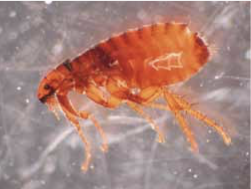
Cat flea
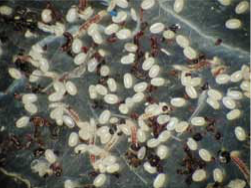
Cat flea larvae, eggs, and particles of dried blood
Silverfish (Order Zygentoma, formerly known as Thysanura): Wingless, silver, up to 1 in. insect with long antennae and three long tail filaments. Habits: Found in undisturbed (often unmaintained), indoor, humid environments. Sometimes found in attics. Eats mold and fungi, paper, etc. Interventions: Moisture is very important to these pests so an effective strategy would be to dry the environment with dehumidifiers. In conjunction with dehumidification apply a granular bait or apply a spot treatment with an appropriately labeled residual spray to areas where these insects are found. Might Be Confused With: cockroaches, crickets, earwigs.
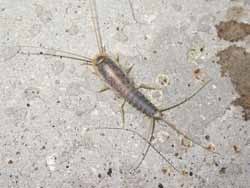
Silverfish
Springtails (Order Collembola): Very small (1/32 to 1/16 in.), usually numerous, jumping insects. Some species referred to as snow fleas. Vary in color from blue to gray to green to brown to white. Habits: Highly moisture-dependent. Outbreaks often occur where there exists persistent, excessive moisture and optimum temperatures. Springtails feed on mold and fungi. Recurring problems indoors suggest an indoor moisture problem or moisture source, such as in bathrooms where insects are sometimes found in bathtubs and sinks or coming from inside damp walls or other damp voids. Springtails are perhaps the most common insect in the soil/leaf litter habitat. Outdoors, outbreaks often occur from thatch or mulch. When this occurs, numerous springtails can be seen jumping, as their name suggests. Interventions: Reduce or eliminate moisture or humidity indoors and outdoors where springtails are found; this may require fixing a leak or eliminating another obvious moisture source. Install a dehumidifier. If springtails are a problem outdoors, follow suggestions under section Proactive Pest Management. When moisture problems are remedied, springtail problems often cease. If desired, apply a spot treatment to mulch/thatch with an appropriately labeled residual spray to areas where springtails are found. Might Be Confused With: fleas, booklice.
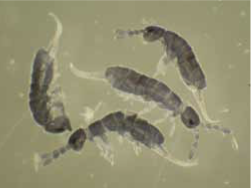
Springtails
Non-Insectan Arthropods
House centipedes (Class Chilopoda: Order Scutigeromorpha: Scutigeridae: Scutigera coleoptrata): Fast-crawling, long-legged, with alternating light and dark gray bands on the legs. A non-insect arthropod with one pair of legs per segment. Long, slender antennae. Habits: Predatory. Feeds on small insects and other invertebrate prey. Found in sheds, garages, log piles, basements, and other undisturbed, humid areas indoors. May bite if handled. Interventions: These predators are found where their food source or prey insects are found. Therefore, reduce prey numbers by following suggestions under section titled Proactive Pest Management. It is especially important to eliminate harborage and install doorsweeps. If desired, apply a spot treatment with an appropriately labeled residual spray where centipedes are found. For more information see University of Georgia Extension Circular 1088, Millipedes and Centipedes, at caes.uga.edu/publications. Might Be Confused With: millipedes.
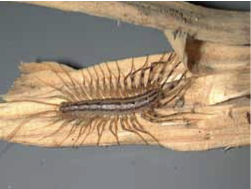
House centipede
Millipedes (Class Diplopoda): Slow-moving, non-insect arthropod, 1 in., with two pairs of legs per segment. Top of each segment glossy brown, white underneath. Habits: General feeder on detritus, mold, fungi, etc. Releases noxious smell when threatened or handled. Often coils when threatened. Because millipedes are desiccation-susceptible, they are found primarily and associated with wet to overly moist conditions. Found outdoors especially under items lying flat on the ground where microhabitats high in humidity are created. Also found in heavily mulched areas. Quickly desiccates and dies in low moisture conditions, such as indoors.Interventions: It is especially important to eliminate harborage (even those far away from the building), dry out the environment, and install doorsweeps. If desired, apply a spot treatment with an appropriately labeled residual spray to millipede harborage sites (spray only outdoors). For more information see University of Georgia Extension Circular 1088, Millipedes and Centipedes, at caes.uga.edu/publications. Might Be Confused With: earthworms, centipedes.
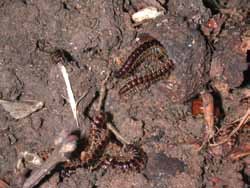
Millipedes
Daddy longlegs (Class Arachnida: Order Phalangida): Also referred to as harvestmen. Daddy longlegs are not spiders. They appear spider-like with eight long, thin legs and three body parts fused into one body part, unlike spiders. Each body part is segmented, also unlike spiders. Habits: Predatory and omnivorous/scavengers. Daddy longlegs cannot bite and are harmless. Internet myths suggesting otherwise are not correct. For discussion on this topic, see the website spiders.ucr.edu. Interventions: Because they are harmless, no control is necessary. Keep vegetation away from house, keep window screens in good repair, and install doorsweeps to limit access to the interior. Might Be Confused With: multiple spider species.
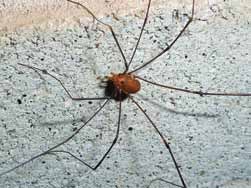
Daddy longlegs
Velvet mites (Class Arachnida: Order Trombidiformes): A large mite, up to 1/16 in., with 8 legs and a bright red-colored body covered with fine hairs, giving it a velvety appearance. Constantly crawling; rarely, if ever, at rest. Commonly found on brick or concrete surfaces, often in large numbers, during the hottest part of the summer in Georgia. Adult mites, with 8 legs like other arachnids, are very small (microscopic), oval-shaped with a pair of long legs pointing forward that are often mistaken for antennae. Acarine larvae normally have 6 legs rather than 8. Habits:Beneficial (feed on other mites and tiny insects and their eggs), seasonal, do not bite. Interventions: Keeping doors and windows tightly sealed can be effective in preventing mite entry into the house. Weatherproof windows and doors where mites may be entering. Live mites are easily crushed but will stain walls, carpet and drapes. If desired, apply a spot treatment of an appropriately labeled residual spray to walls and other outdoor surfaces where mites are most commonly found. Indoor insecticide applications are not recommended because it will not provide relief beyond what vacuuming can accomplish. Might Be Confused With: larval ticks (referred to as seed ticks).
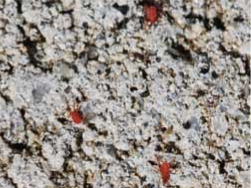
Velvet mites
Scorpions (Class Arachnida: Order Scorpionida): Large (1.25 to 1.5 in.), non-insect arthropod with forward pinchers and a long, strongly segmented tail tipped with a sting. Habits: Scorpions sting, so should be handled with care. Scorpions feed on insects and other arthropods and are found outdoors in wood piles and under flat items (such as boards, rock piles, etc.) lying on the ground. Sometimes found under tree bark. May be found in homes, often with numerous cracks and crevices to hide, that have gone uninhabited for long periods—i.e., buildings that are only intermittently heated or occupied (hunting cabins, second homes, etc.). Scorpions are secretive. Interventions: The best remedy is to crush individual scorpions. Also, follow suggestions under section Proactive Pest Management. Install doorsweeps on all exterior doors. It is especially important to eliminate harborage for scorpions and their insect prey. On the rare occasion when scorpions are so numerous that their presence requires a chemical intervention, spray them directly or apply a spot treatment with an appropriately labeled residual spray to areas where scorpions are found. For more information see University of Georgia Extension Circular 782, Stinging and Biting Pests, at caes.uga.edu/publications. Might Be Confused With: cockroaches.

Scorpion
Ticks (Class Arachnida: Order Ixodida): Oblong to oval, 1/8 to 3/16 in., six-legged (larvae) or eight-legged (nymphs and adults), black- to brown- to cherry- colored, slow-moving, non-insect arthropod. Some species with distinct markings on their back. The term seed tick refers to a first instar larval tick just hatched from the egg; seed ticks are barely visible to the naked eye and often encountered in large numbers. Habits: Ticks are obligate parasites that suck blood that is needed for egg production. In nature, ticks are common parasites of warm-blooded animals (e.g., deer, raccoons, coyotes, etc.). Some species attach to and feed on humans. Some species transmit disease, with Rocky Mountain Spotted Fever being much more common than Lyme Disease in Georgia; Lyme Disease is not common in Georgia. Like other blood-feeding arthropods (bed bugs, fleas, and mosquitoes), ticks are attracted to carbon dioxide, as it is indicative of a warm-blooded host. Interventions: Keep grass cut low. To avoid tick bites: (a) use an EPA registered repellent (see cfpub.epa.gov/ oppref/insect), (b) wear protective clothing (e.g., tuck pant legs into socks when in tick-infested habitat), (c) perform tick checks following outdoor activities in tick-infested habitat, and (d) if possible, shower soon after returning from tick-infested habitat. If desired, apply a spot treatment with an appropriately labeled residual spray to areas where ticks are found. For more information see University of Georgia Extension Circulars 937, Protect Yourself from Ticks, and 782, Stinging and Biting Pests, at caes.uga.edu/publications. Might Be Confused With: mites, chiggers.
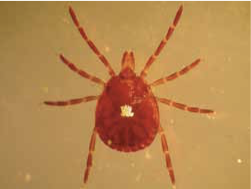
Lonestar tick
Sowbugs & Pillbugs (Class Malacostraca: Order Isopoda): Clearly segmented, 1/4 in., oblong, flat gray, non-insect, slow-moving arthropod. Habits: Found in log piles, leaf litter, and under flat items, such as boards, lying on the ground. Because these creatures are desiccation-susceptible, they are found primarily in and are associated with wet to overly moist conditions. Common occurrence is suggestive of a persistently moist to wet environment. General feeder on detritus, mold, fungi, etc. Interventions: Follow suggestions under section titled Proactive Pest Management. It is especially important to eliminate excessive harborage, install doorsweeps, and eliminate excessive moisture problems. In the rare case that a pesticide treatment is needed, apply a spot treatment with an appropriately labeled residual spray (spray only outdoors). Might Be Confused With: ground beetles.
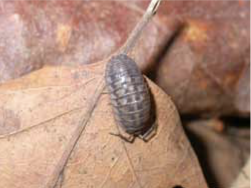
Pillbug
Acknowledgements
We thank Terry W. Bowen, B.S., B.C.E. (Peachtree Pest Control, Atlanta, Ga); Richard Spencer (Arrow Exterminators, Atlanta, Ga); and Tim Daly and Wade Hutcheson (University of Georgia Cooperative Extension) for their thoughtful review of this bulletin. Sam Pittard (University Printing) for design and layout. Printed by University Printing, Athens, Ga, www.printing.uga.edu.
About the Authors
Daniel Suiter (dsuiter@uga.edu) and Brian Forschler (bfor@uga.edu) are Professors of Entomology, specializing in urban entomology, in the Department of Entomology at the University of Georgia; Suiter is located on the university’s campus in Griffin, while Forschler is on the main campus in Athens, Ga. Lisa Ames (lames@uga.edu) directs the Homeowner Insect and Weed Diagnostics Laboratory on the UGA Griffin Campus. E. Richard Hoebeke, a systematic entomologist, is the associate curator of insects at the Georgia Museum of Natural History on the UGA’s main campus in Athens, Ga (rhoebeke@uga.edu).
Photo Credits
Unless noted, all photos by Daniel Suiter or Lisa Ames, UGA Entomology.
Status and Revision History
Published on Feb 22, 2013
Published with Full Review on Mar 28, 2017
Published with Full Review on May 29, 2020
Published with Major Revisions on Oct 20, 2023


























































